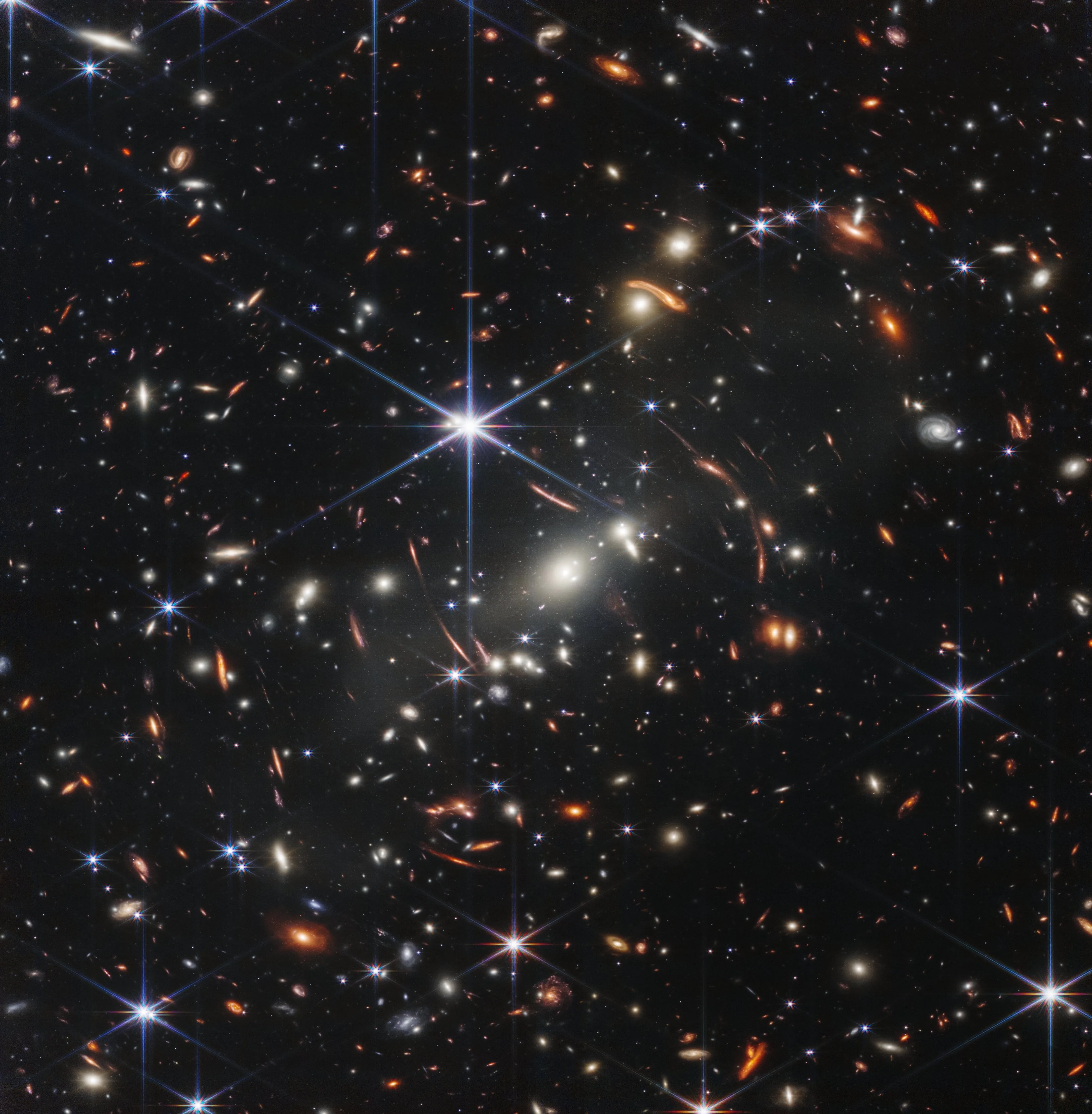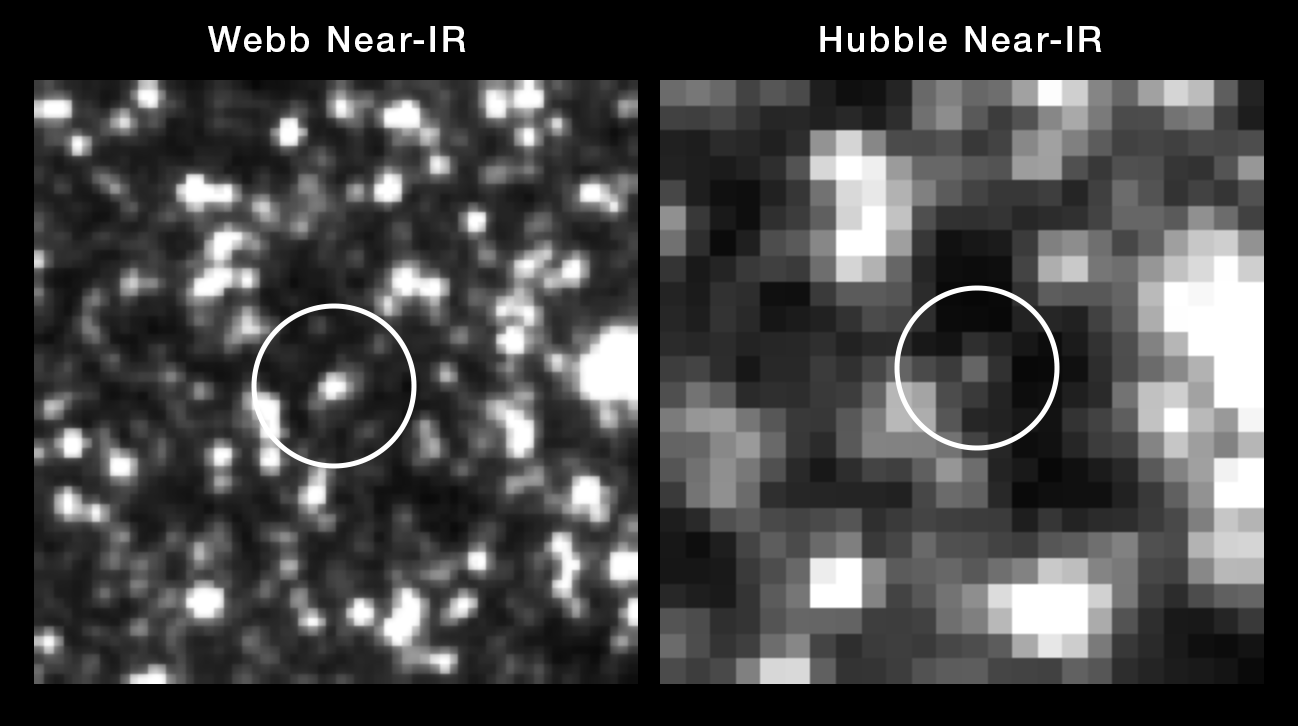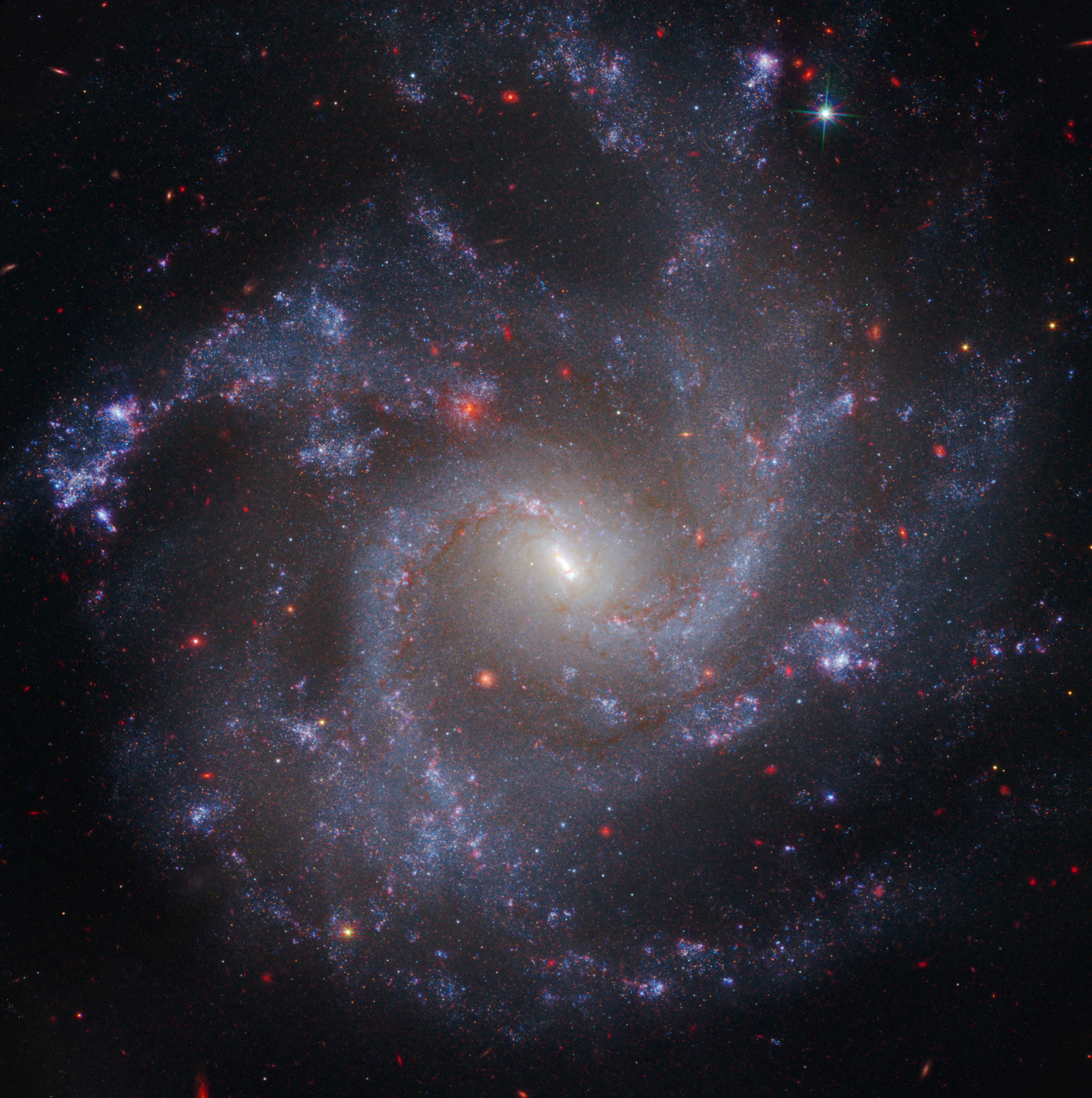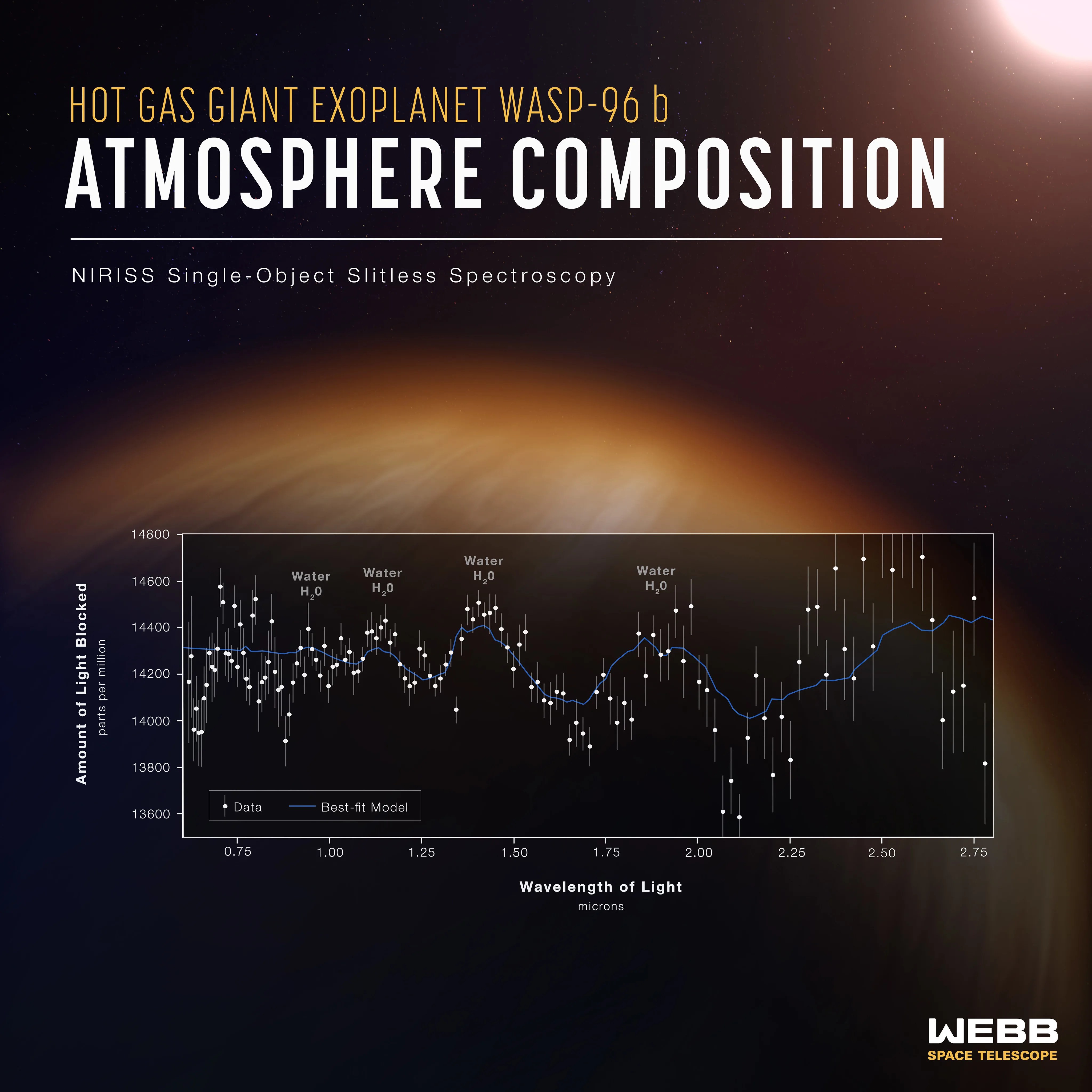James Webb Space Telescope - Science images
Two mid-infrared images from NASA’s James Webb Space Telescope of Wolf-Rayet 140 show carbon-rich dust moving in space. At right,...

A portion of Webb’s 2023 observation of Wolf-Rayet 140.

A view of the famous Sombrero Galaxy in mid-infrared light from NASA’s James Webb Space Telescope’s MIRI (Mid-Infrared Instrument) that...

A view of the famous Sombrero Galaxy in visible light from NASA’s Hubble Space Telescope.

This image compares the view of the famous Sombrero Galaxy in mid-infrared light (top) and visible light (bottom). NASA’s James...

NASA’s James Webb Space Telescope recently imaged the Sombrero galaxy with its MIRI (Mid-Infrared Instrument), resolving the clumpy nature of...


Webb acquired this image of the circumstellar disk around the star Vega using the Mid-Infrared Instrument (MIRI).

The Webb View of spiral galaxies IC 2163 and NGC 2207. James Webb Space Telescope’s mid-infrared light.

The Hubble View of spiral galaxies IC 2163 and NGC 2207. NASA’s Hubble Space Telescope’s ultraviolet- and visible-light view.

These are two views of spiral galaxies IC 2163 and NGC 2207. NASA’s Hubble Space Telescope’s ultraviolet- and visible-light view...

This mid-infrared image from NASA’s James Webb Space Telescope excels at showing where the cold dust, set off in white,...

This observation combines mid-infrared light from NASA’s James Webb Space Telescope, and ultraviolet and visible light from NASA’s Hubble Space...

NASA’s James Webb Space Telescope’s NIRCam (Near-Infrared Camera) image of the galaxy cluster PLCK G165.7+67.0, also known as G165, on...

An artist’s concept of Centaur 29P/Schwassmann-Wachmann 1’s outgassing activity as seen from the side. While prior radio-wavelength observations showed a...

A team of scientists used NASA’s James Webb Space Telescope’s spectrographic capabilities to gather data on Centaur 29P/Schwassmann-Wachmann 1, one...

What appears as a faint dot in this James Webb Space Telescope image may actually be a groundbreaking discovery. Detailed...

This comparison of the data collected by the James Webb Space Telescope with a computer model prediction highlights the same...

This composite image of Arp 107, created with data from the James Webb Space Telescope’s NIRCam (Near-Infrared Camera) and MIRI...

This image of Arp 107, shown by Webb’s MIRI (Mid-Infrared Instrument), reveals the supermassive black hole that lies in the...

Annotated image of Digel Cloud 2S captured by Webb's NIRCam (Near-Infrared Camera) and MIRI (Mid-Infrared Instrument), with compass arrows, a...

Scientists used NASA’s James Webb Space Telescope to examine select star-forming areas in the Extreme Outer Galaxy in near- and...

The galaxy cluster MACS-J0417.5-1154 is so massive it is warping the fabric of space-time and distorting the appearance of galaxies...

Wide Field View: The galaxy cluster MACS-J0417.5-1154 is so massive it is warping the fabric of space-time and distorting the...

Hubble View: NASA’s Hubble Space Telescope has also observed the galaxy cluster MACS-J0417.5-1154, but the dusty red galaxy that appears...

Webb View: NASA’s Hubble Space Telescope has also observed the galaxy cluster MACS-J0417.5-1154, but the dusty red galaxy that appears...

NASA’s Hubble Space Telescope has also observed the galaxy cluster MACS-J0417.5-1154, but the dusty red galaxy that appears multiple times...

This image shows a small portion of the field observed by NASA’s James Webb Space Telescope’s NIRCam (Near-Infrared Camera) for...

This image of the gas-giant exoplanet Epsilon Indi Ab was taken with the coronagraph on NASA’s James Webb Space Telescope’s...

This artist’s concept shows what the exoplanet WASP-39 b could look like based on indirect transit observations from NASA’s James...

This transmission spectrum, captured using Webb’s NIRSpec (Near-Infrared Spectrograph) PRISM bright object-time series mode, shows the amounts of different wavelengths...

A light curve from NASA’s James Webb Space Telescope’s NIRSpec (Near-Infrared Spectrograph) shows the change in brightness from the star...

NASA’s James Webb Space Telescope’s mid-infrared view of interacting galaxies Arp 142 seems to sing in primary colors. The Egg...

The distorted spiral galaxy at center, the Penguin, and the compact elliptical at left, the Egg, are locked in an...

NASA’s Hubble Space Telescope captured visible light when observing Arp 142, nicknamed the Penguin and the Egg, with its Wide...

NASA’s Hubble Space Telescope captured visible light when observing Arp 142, nicknamed the Penguin and the Egg, with its Wide...

L1527, shown in this image from NASA’s James Webb Space Telescope’s MIRI (Mid-Infrared Instrument), is a molecular cloud that harbors...

In this image of the Serpens Nebula from NASA’s James Webb Space Telescope, astronomers found a grouping of aligned protostellar...
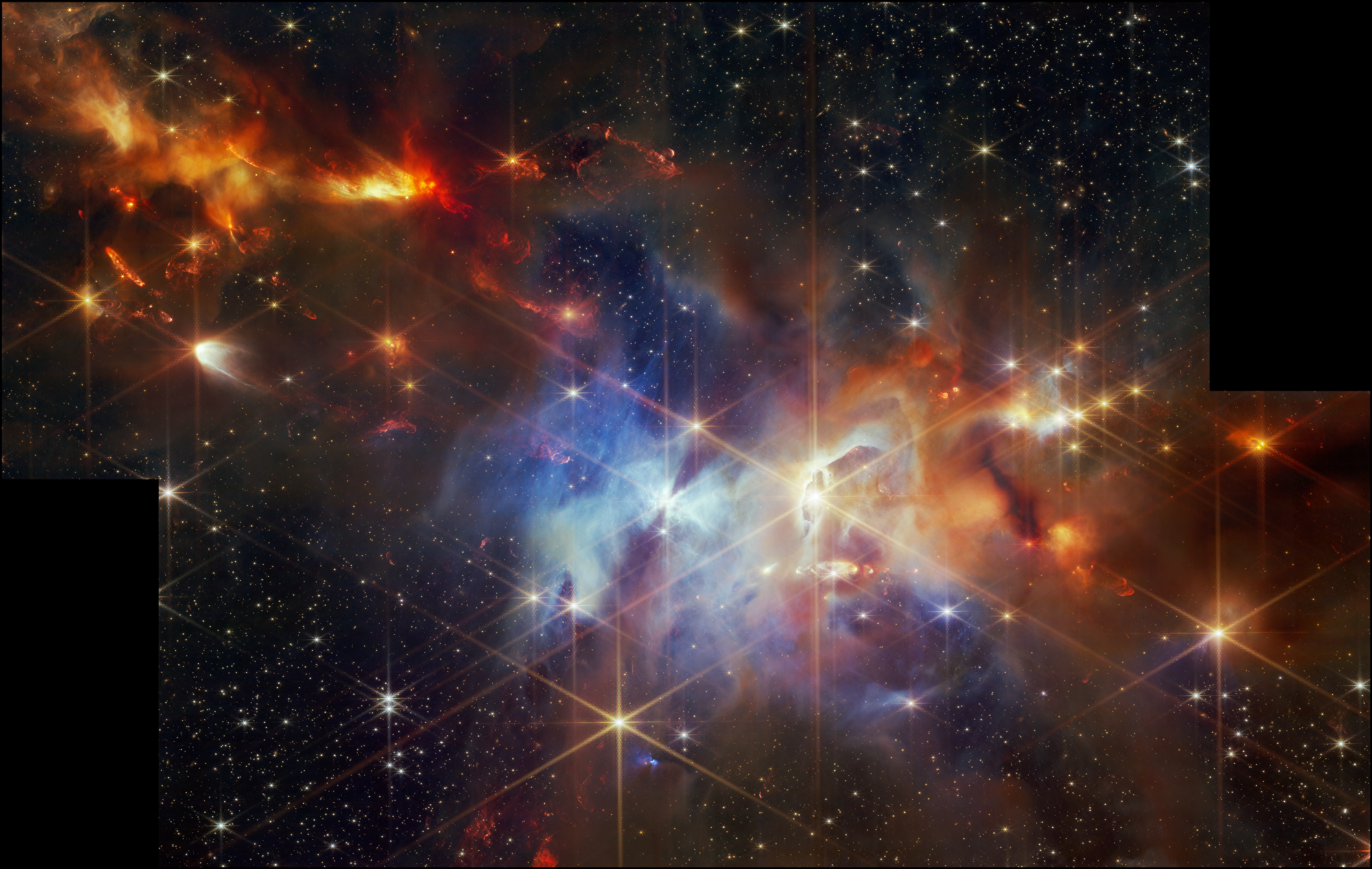
This video shows the different major components that compose the Crab Nebula as observed by the James Webb Space Telescope....
This image by NASA’s James Webb Space Telescope’s NIRCam (Near-Infrared Camera) and MIRI (Mid-Infrared Instrument) shows different structural details of...

The JADES Deep Field uses observations taken by NASA’s James Webb Space Telescope (JWST) as part of the JADES (JWST...

The JADES Deep Field uses observations taken by NASA’s James Webb Space Telescope (JWST) as part of the JADES (JWST...

This mosaic displays three of about 80 transients, or objects of changing brightness, identified in data from the JADES (JWST...

This mosaic displays three of about 80 transients, or objects of changing brightness, identified in data from the JADES (JWST...

The JADES Deep Field uses observations taken by NASA’s James Webb Space Telescope (JWST) as part of the JADES (JWST...

The JADES Deep Field uses observations taken by NASA’s James Webb Space Telescope (JWST) as part of the JADES (JWST...

The spectrum of the star ISO-ChaI 147 revealed by NASA's James Webb Space Telescope’s MIRI (Mid-Infrared Instrument) shows the richest...

This is an artist’s impression of a young star surrounded by a disk of gas and dust. An international team...

This infographic compares the characteristics of three classes of stars in our galaxy: Sunlike stars are classified as G stars;...

This infrared image from NASA’s James Webb Space Telescope (also called Webb or JWST) was taken by the NIRCam (Near-Infrared...

This illustration shows a galaxy forming only a few hundred million years after the big bang, when gas was a...

This artist’s concept shows what the warm Neptune exoplanet WASP-107 b could look like based on recent data gathered by...

This transmission spectrum, captured using NASA’s Hubble and James Webb space telescopes, shows the amounts of different wavelengths (colors) of...

This transmission spectrum, captured using Webb’s NIRSpec (Near-Infrared Spectrograph) Bright Object Spectrometer, shows the amounts of different wavelengths (colors) of...

A light curve of 7.5- to 11.8-micron light captured by NASA’s James Webb Space Telescope’s MIRI (Mid-Infrared Instrument) in March...

A thermal emission spectrum of the super-Earth exoplanet 55 Cancri e, captured by NASA’s James Webb Space Telescope’s NIRCam (Near-Infrared...

This artist's concept shows what the exoplanet 55 Cancri e could look like based on observations from NASA’s James Webb...
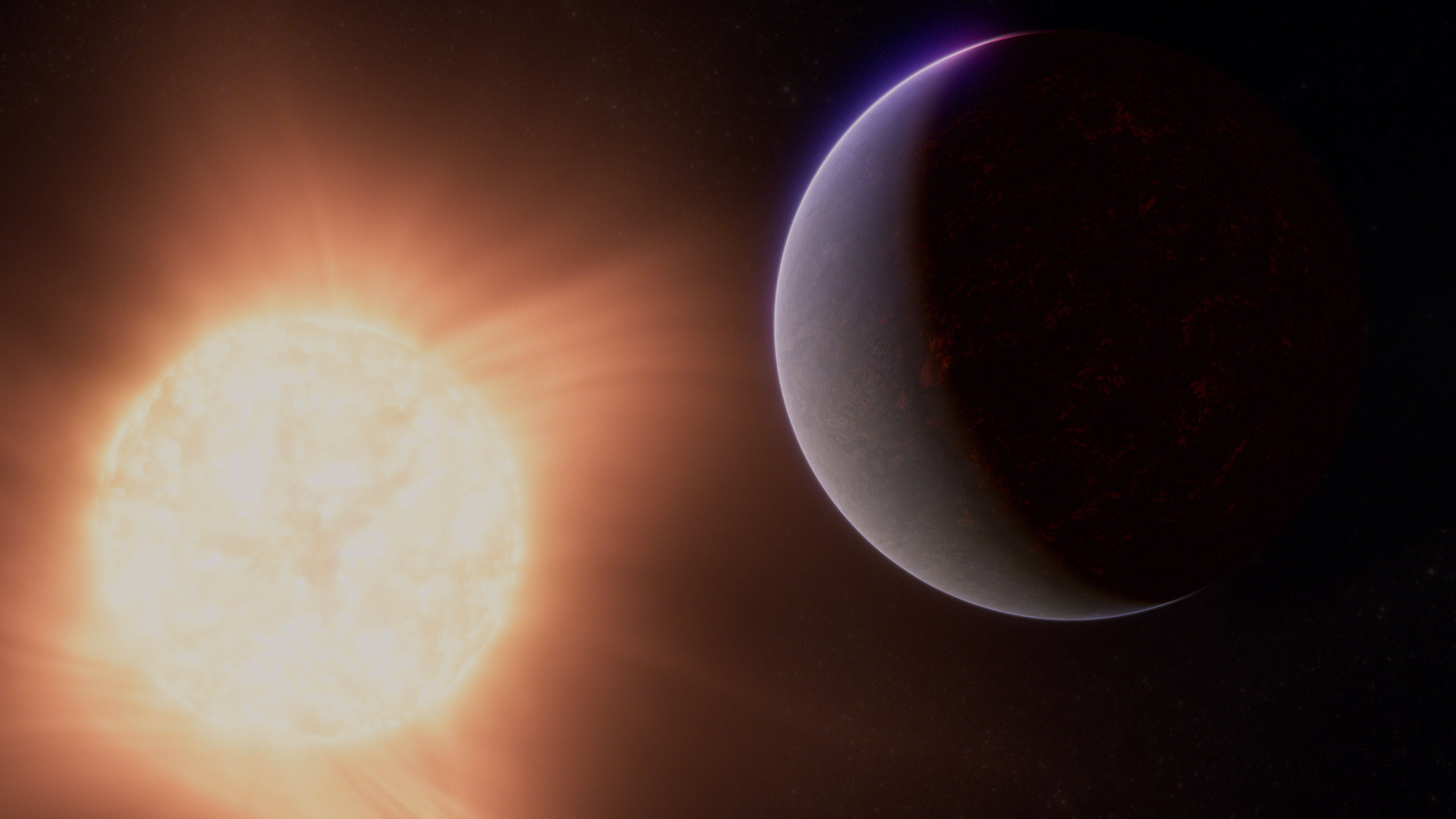
This image from NASA’s James Webb Space Telescope of a massive galaxy cluster called WHL0137-08 contains the most strongly magnified...

CEERS (NIRCam Compass Image)

Webb’s infrared image of the galaxy cluster El Gordo (“the Fat One”) reveals hundreds of galaxies, some never before seen...

The Pillars of Creation are set off in a kaleidoscope of color in NASA’s James Webb Space Telescope’s near-infrared-light view....

This graphic presentation compares the spectral data of GRB 230307A’s kilonova as observed by NASA’s James Webb Space Telescope and...

NIRCam (the Near Infrared Camera) on NASA’s James Webb Space Telescope captured this picture of the surface of Jupiter’s moon...

The two stars in Wolf-Rayet 140 produce shells of dust every eight years that look like rings, as seen in...

What do we see in Webb's latest image of the ice giant Neptune? Webb captured seven of Neptune’s 14 known...

This image by NASA’s James Webb Space Telescope’s NIRCam (Near-Infrared Camera) and MIRI (Mid-Infrared Instrument) reveals new details in infrared...

ILLUSTRATION: This artist’s concept shows what the hot gas giant exoplanet WASP-17 b could look like based on observations from...

This wider view of the Uranian system with Webb’s NIRCam instrument features the planet Uranus as well as six of...

This side-by-side comparison of galaxy cluster MACS0416 as seen by the Hubble Space Telescope in optical light (left) and the...

In the MIRI observations of NGC 1365, clumps of dust and gas in the interstellar medium have absorbed the light...

This zoomed-in image of Uranus, captured by Webb’s Near-Infrared Camera (NIRCam) Feb. 6, 2023, reveals stunning views of the planet’s...

A transmission spectrum of the hot gas giant exoplanet WASP-17 b captured by the Mid-Infrared Instrument (MIRI) on NASA’s James...

This side-by-side comparison of the Crab Nebula as seen by the Hubble Space Telescope in optical light (left) and the...

More than 13 billion years ago, during the Era of Reionization, the universe was a very different place. The gas...

Cassiopeia A (Cas A) is a supernova remnant located about 11,000 light-years from Earth in the constellation Cassiopeia. It spans...

This image from the Kitt Peak National Observatory of NGC 6496 contextualizes the locations of Supernova 2004et and Supernova 2017eaw...

A previously unknown 100–200-metre asteroid — roughly the size of Rome’s Colosseum — has been detected by an international team...

This image of Uranus from NIRCam (Near-Infrared Camera) on NASA’s James Webb Space Telescope exquisitely captures Uranus’s seasonal north polar...

The luminous, hot star Wolf-Rayet 124 (WR 124) is prominent at the center of the James Webb Space Telescope’s composite...

NASA’s James Webb Space Telescope has captured a tightly bound pair of actively forming stars, known as Herbig-Haro 46/47, in...

Artist’s Concept: This artist’s concept compares two types of typical, planet-forming disks around newborn, Sun-like stars. On the left is...

This deep galaxy field from Webb’s NIRCam (Near-Infrared Camera) shows an arrangement of 10 distant galaxies marked by eight white...

This graphic compares the dayside temperature of TRAPPIST-1 b as measured using Webb’s Mid-Infrared Instrument (MIRI) to computer models of...

Webb’s NIRCam (Near-Infrared Camera) instrument reveals the star, nicknamed Earendel, to be a massive B-type star more than twice as...

The James Webb Space Telescope’s Near-Infrared Spectrograph captured the chemical fingerprints of selected galaxies behind SMACS 0723, including three faint,...

What do we see in Webb’s latest image of the ice giant Neptune? Webb captured seven of Neptune’s 14 known...

This artist’s concept portrays the star PDS 70 and its inner protoplanetary disk. New measurements by NASA’s James Webb Space...

This graphic shows detections of the most distant active supermassive black holes currently known in the universe. They were identified...

NASA’s James Webb Space Telescope’s mid-infrared view of the Pillars of Creation strikes a chilling tone. Thousands of stars that...

This spectrum shows data from the protoplanetary disk termed XUE 1, which is located in the star cluster Pismis 24....

This image of the dusty debris disk surrounding the young star Fomalhaut is from Webb’s Mid-Infrared Instrument (MIRI). It reveals...

NASA's Hubble Space Telescope made the Pillars of Creation famous with its first image in 1995, but revisited the scene...

This image highlights several interesting features of supernova remnant Cassiopeia A as seen with Webb’s NIRCam (Near-Infrared Camera): NIRCam’s exquisite...

This panchromatic view of galaxy cluster MACS0416 was created by combining infrared observations from NASA’s James Webb Space Telescope with...

This graphic presentation of spectral data highlights a key similarity and difference between observations of Comet 238P/Read by the NIRSpec...

This light curve shows the change in brightness of the TRAPPIST-1 system as the second planet, TRAPPIST-1 c, moves behind...

This image from Webb’s Mid-Infrared Instrument (MIRI) shows a group of galaxies, including a large distorted ring-shaped galaxy known as...

This deep galaxy field from Webb’s NIRCam (Near-Infrared Camera) shows an arrangement of 10 distant galaxies marked by eight white...

A stunning smash-up of two spiral galaxies shines in infrared with the light of more than a trillion suns. Collectively...

This image from the NIRCam (Near-Infrared Camera) instrument on NASA’s James Webb Space Telescope shows the central portion of the...

This image of NGC 6946 highlighting two supernovae, SN 2004et and SN 2017eaw, by Webb’s MIRI (Mid-Infrared Camera), shows compass...

This animation, a timelapse of images from NASA’s James Webb Space Telescope, covers the time spanning just before impact at...


This graphic shows the transmission spectrum obtained by Webb observations of rocky exoplanet GJ 486 b. The science team’s analysis...


This image of Uranus, captured by Webb’s Near-Infrared Camera (NIRCam), shows compass arrows, scale bar, and color key for reference....

Wolf-Rayet stars are known to be efficient dust producers, and the Mid-Infrared Instrument on NASA’s James Webb Space Telescope shows...

In this mosaic image stretching 340 light-years across, Webb’s Near-Infrared Camera (NIRCam) displays the Tarantula Nebula star-forming region in a...

Images from NASA’s James Webb Space Telescope reveal large amounts of dust within Supernova 2004et and Supernova 2017eaw. These supernovae...

Images from NASA’s James Webb Space Telescope reveal large amounts of dust within Supernova 2004et and Supernova 2017eaw. These supernovae...

This image of Jupiter from NASA’s James Webb Space Telescope’s NIRCam (Near-Infrared Camera) shows stunning details of the majestic planet...

Captured in infrared light by the Near-Infrared Camera (NIRCam), the seemingly three-dimensional “Cosmic Cliffs” showcases Webb’s capabilities to peer through...

Spectra of K2-18 b, obtained with Webb’s NIRISS (Near-Infrared Imager and Slitless Spectrograph) and NIRSpec (Near-Infrared Spectrograph), display an abundance...

This graph compares the measured brightness of TRAPPIST-1 c to simulated brightness data for three different scenarios. The measurement (red...

In this artist concept, the young star SZ Chamaeleontis (SZ Cha) is surrounded by a disk of dust and gas...

This image of galaxy cluster MACS0416 highlights one particular gravitationally lensed background galaxy, which existed about 3 billion years after...

This image provides a side-by-side comparison of supernova remnant Cassiopeia A (Cas A) as captured by NASA’s James Webb Space...

The seven galaxies highlighted in this James Webb Space Telescope image have been confirmed to be at a distance that...

A delicate tracery of dust and bright star clusters threads across this image from the NASA/ESA/CSA James Webb Space Telescope....

This spectrum shows data from the protoplanetary disk termed XUE 1, which is located in the star cluster Pismis 24....

This image of the Cartwheel and its companion galaxies is a composite from Webb’s Near-Infrared Camera (NIRCam) and Mid-Infrared Instrument...

This new infrared image of NGC 346 from NASA’s James Webb Space Telescope’s Mid-Infrared Instrument (MIRI) traces emission from cool...


By analyzing new observations from NASA’s James Webb Space Telescope, a team led by Simon Lilly of ETH Zürich in...

A spectrum of the protoplanetary disk of PDS 70, obtained with Webb’s MIRI (Mid-Infrared Instrument), displays a number of emission...

These Webb images show a part of the Orion Nebula known as the Orion Bar. The largest image, on the...

NGC 346, shown here in this image from NASA’s James Webb Space Telescope Near-Infrared Camera (NIRCam), is a dynamic star...

Contrasting data from NASA’s James Webb and Spitzer space telescopes show change in the disk surrounding the star SZ Chamaeleontis...

This artist’s concept shows what exoplanet K2-18 b could look like based on science data. K2-18 b, an exoplanet 8.6...

Astronomers estimate 50,000 sources of near-infrared light are represented in this image from NASA’s James Webb Space Telescope. Their light...

A green pea galaxy imaged by the Sloan Digital Sky Survey is shown alongside an infrared picture of an early...

In this image, NASA’s James Webb Space Telescope shows a water vapor plume jetting from the southern pole of Saturn’s...

Four mercury-cadmium-telluride detectors for Webb’s NIRCam instrument, which capture light in the 0.6 – 2.5 µm range. Ames led development...

This image of Comet 238P/Read was captured by the NIRCam (Near-Infrared Camera) instrument on NASA’s James Webb Space Telescope on...

This illustration shows what exoplanet WASP-39 b could look like, based on current understanding of the planet. WASP-39 b is...

Webb’s Near-Infrared Camera (NIRCam) images objects in the near-infrared range from 0.6 to 5 microns, so Neptune does not appear...

This image taken by Webb’s NIRCam (Near-Infrared Camera) shows a part of the Orion Nebula known as the Orion Bar....

Webb’s NIRCam (Near-Infrared Camera) captured this detailed image of SN 1987A (Supernova 1987A), which has been annotated to highlight key...

This image from the NIRCam (Near-Infrared Camera) instrument on NASA’s James Webb Space Telescope shows the central portion of the...

The atmospheric composition of the hot gas giant exoplanet WASP-39 b has been revealed by NASA’s James Webb Space Telescope....

A research team led by Brittany Miles of the University of Arizona used two instruments known as spectrographs aboard the...

NASA’s James Webb Space Telescope’s new view of Cassiopeia A (Cas A) in near-infrared light is giving astronomers hints at...

At the longer wavelengths of light captured by its Mid-Infrared Instrument (MIRI), Webb focuses on the area surrounding the central...

A delicate tracery of dust and bright star clusters threads across this image from the NASA/ESA/CSA James Webb Space Telescope....

Jupiter has a layered atmosphere, and this illustration displays how NASA’s James Webb Space Telescope is uniquely capable of collecting...

NASA’s James Webb Space Telescope offers dramatically different views of the Southern Ring Nebula. Each image combines near- and mid-infrared...

The NASA/ESA/CSA James Webb Space Telescope reveals intricate details of the Herbig Haro object 797 (HH 797). Herbig-Haro objects are...

Slice of image taken out of artist’s concept that compares two types of typical, planet-forming disks around newborn, Sun-like stars....

NASA’s James Webb Space Telescope has returned extraordinarily detailed near-infrared images of galaxies that existed when the universe was only...

This image shows where the James Webb Space Telescope will observe the sky within the Hubble Ultra Deep Field, which...

NASA’s James Webb Space Telescope’s high resolution, near-infrared look at Herbig-Haro 211 reveals exquisite detail of the outflow of a...

A series of light curves from Webb’s Near-Infrared Spectrograph (NIRSpec) shows the change in brightness of three different wavelengths (colors)...

A transmission spectrum of the hot gas giant exoplanet WASP-39 b captured by Webb’s Near-Infrared Spectrograph (NIRSpec) July 10, 2022,...

This artist’s concept shows what the hot rocky exoplanet TRAPPIST-1 c could look like based on this work. TRAPPIST-1 c,...

Examine the straight, brightly-lit lines that pierce through the rings of gas and dust around the edges of the Southern...

Researchers using NASA’s James Webb Space Telescope’s NIRCam (Near-Infrared Camera) have discovered a high-speed jet stream sitting over Jupiter’s equator,...

This artist’s concept depicts the planet GJ 1214 b, a “mini-Neptune” with what is likely a steamy, hazy atmosphere. A...

A delicate tracery of dust and bright star clusters threads across this image from the NASA/ESA/CSA James Webb Space Telescope....

At left, the quasar SDSS J165202.64+172852.3 is highlighted in a Hubble Space Telescope image taken in visible and near-infrared light....

These two images are of the dusty debris disk around AU Mic, a red dwarf star located 32 light-years away...

This image from Webb’s MIRI (Mid-Infrared Instrument) shows a small region of the Orion Nebula. At the center of this...

Stare deeply at this vast landscape. It was stitched together from multiple images captured by the James Webb Space Telescope...


This image of the dusty debris disk surrounding the young star Fomalhaut is from Webb’s Mid-Infrared Instrument (MIRI). It reveals...



Approximate outlines help to define the features in the Sagittarius C (Sgr C) region. Astronomers are studying data from NASA’s...

A trio of faint objects (circled) captured in the James Webb Space Telescope’s deep image of the galaxy cluster SMACS...

Illustration showing what exoplanet 55 Cancri e could look like, based on current understanding of the planet. 55 Cancri e...

This image from NASA’s James Webb Space Telescope NIRCam (Near-Infrared Camera) instrument highlights Gamma-Ray Burst (GRB) 230307A and its associated...

This light curve shows the change in brightness of the TRAPPIST-1 system as the innermost planet, TRAPPIST-1 b, moves behind...

Infographic ICY Pebble Drift: This graphic is an interpretation of data from Webb’s MIRI, the Mid-Infrared Instrument, which is sensitive...

Three faint, small, distant galaxies (in boxes) appear in the James Webb Space Telescope’s deep image of the galaxy cluster...

The spiral arms of NGC 7496 are filled with cavernous bubbles and shells overlapping one another in this image from...

This infrared image from NASA’s James Webb Space Telescope (JWST) was taken for the JWST Advanced Deep Extragalactic Survey, or...

This video tours the Crab Nebula, a supernova remnant that lies 6,500 light-years away in the constellation Taurus. Despite this...
This compass image shows a deep galaxy field imaged by Webb’s NIRCam (Near-Infrared Camera) for the ASPIRE program. The field...

Illustration comparing rocky exoplanets LHS 3844 b and 55 Cancri e to Earth and Neptune. Both 55 Cancri e and...

Wolf-Rayet stars are known to be efficient dust producers, and the Mid-Infrared Instrument (MIRI) on NASA’s James Webb Space Telescope...

This illustration shows what the hot rocky exoplanet TRAPPIST-1 b could look like based on this work. TRAPPIST-1 b, the...

This illustration conceptualizes the swirling clouds identified by the James Webb Space Telescope in the atmosphere of exoplanet VHS 1256...


NASA’s James Webb Space Telescope first deep field image is galaxy cluster SMACS 0723. This deep field, taken by Webb’s...

The protostar within the dark cloud L1527, shown in this image from NASA’s James Webb Space Telescope Near-Infrared Camera (NIRCam),...

For the first time, NASA’s James Webb Space Telescope and Hubble Space Telescope have taken simultaneous observations of the same...

New imagery from NASA’s James Webb Space Telescope is giving scientists their first look at high resolution into the fine...

Emission Spectrum – Water Abundance: This graphic compares the spectral data for warm and cool water in the GK Tau...

In this image, NASA’s James Webb Space Telescope’s instruments are revealing details into how one of Saturn’s moon’s feeds a...

This graphic shows a map of Europa’s surface with NIRCam (Near Infrared Camera) on NASA’s James Webb Space Telescope in...

This wide-field image of Uranus from NIRCam (Near-Infrared Camera) on NASA’s James Webb Space Telescope shows the planet amid a...

Two of the farthest galaxies seen to date are captured in these Webb Space Telescope pictures of the outer regions...

The NIRCam (Near-Infrared Camera) instrument on NASA’s James Webb Space Telescope’s reveals a portion of the Milky Way’s dense core...

Webb’s NIRCam (Near-Infrared Camera) captured this detailed image of SN 1987A (Supernova 1987A). At the center, material ejected from the...

Global temperature map of the hot gas-giant exoplanet WASP-43 b. This map was made based on the brightness of 5-...
This artist’s concept shows what the hot gas-giant exoplanet WASP-43 b could look like. WASP-43 b is a Jupiter-sized planet...
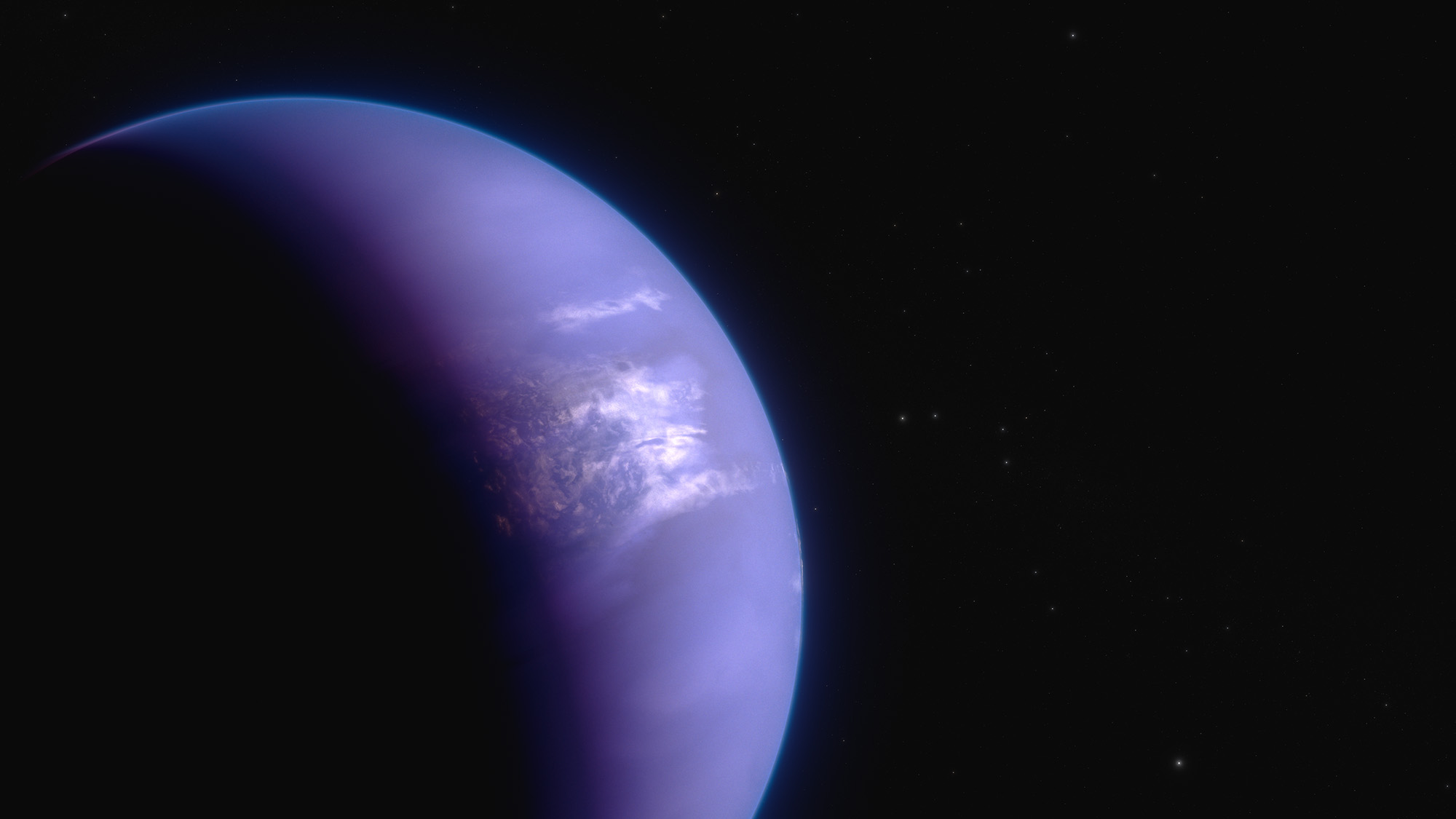
This phase curve, captured by the MIRI low resolution spectrometer on NASA’s James Webb Space Telescope, shows the change in...

This set of maps shows the temperature of the visible side of the hot gas-giant exoplanet WASP-43 b, as it...

This image of the Horsehead Nebula from NASA’s James Webb Space Telescope focuses on a portion of the horse’s “mane.”...

This image showcases three views of one of the most distinctive objects in our skies, the Horsehead Nebula. The first...
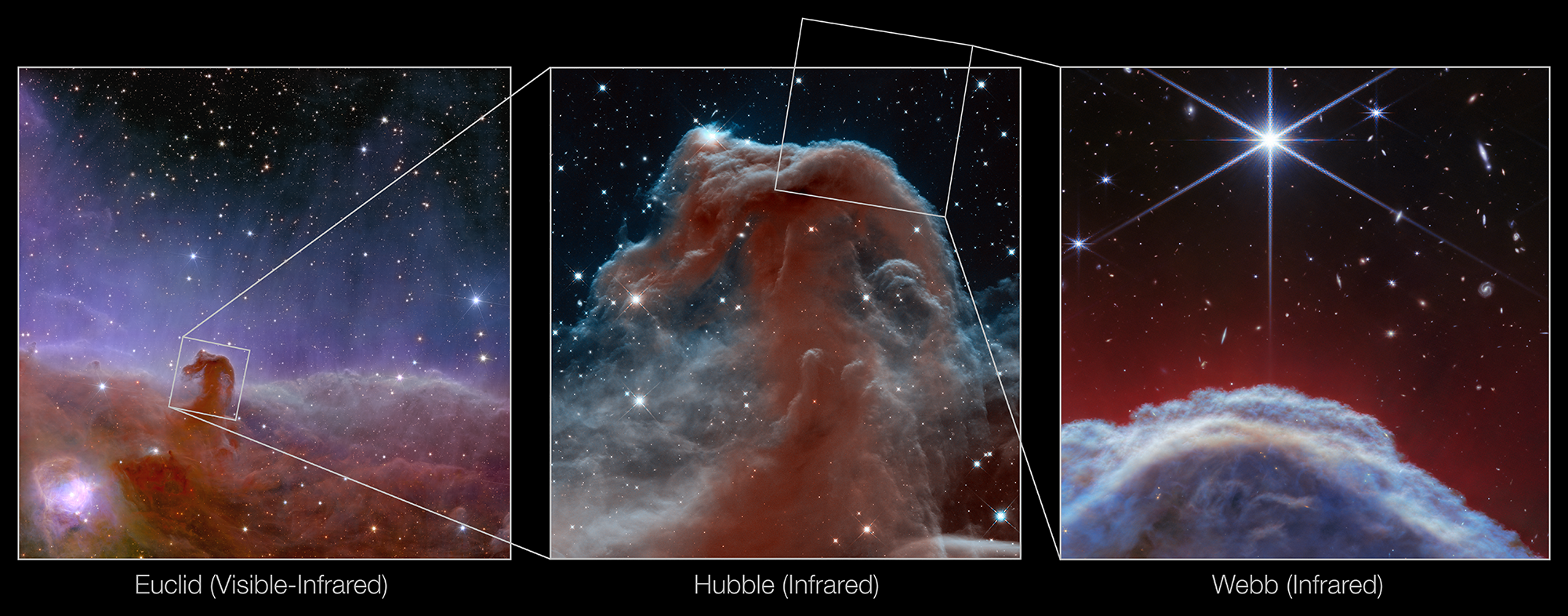
This image of the Horsehead Nebula from NASA’s James Webb Space Telescope focuses on a portion of the horse’s “mane”...
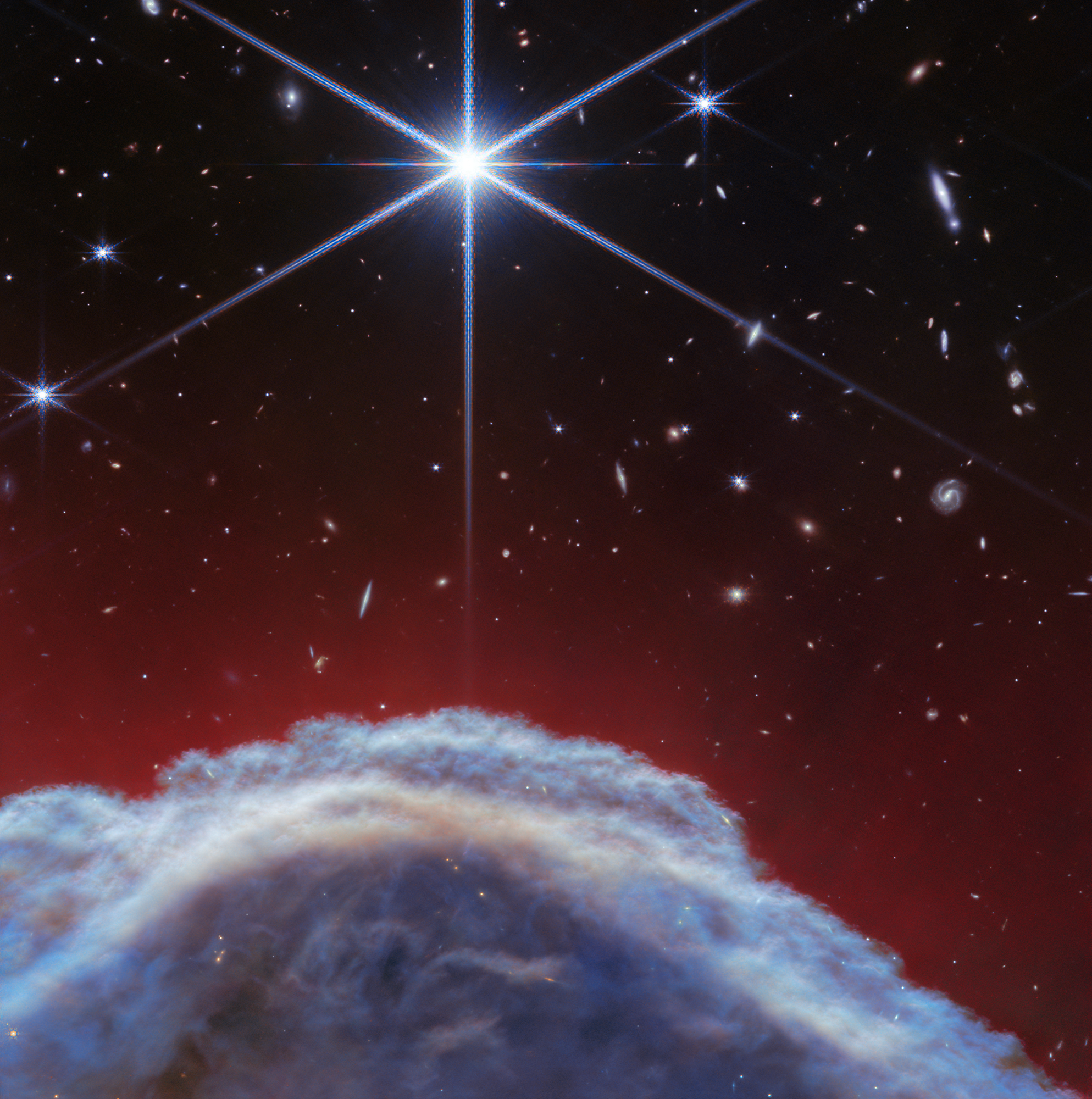
On the left is the starburst galaxy M82 as observed by NASA’s Hubble Space Telescope in 2006. The small box...
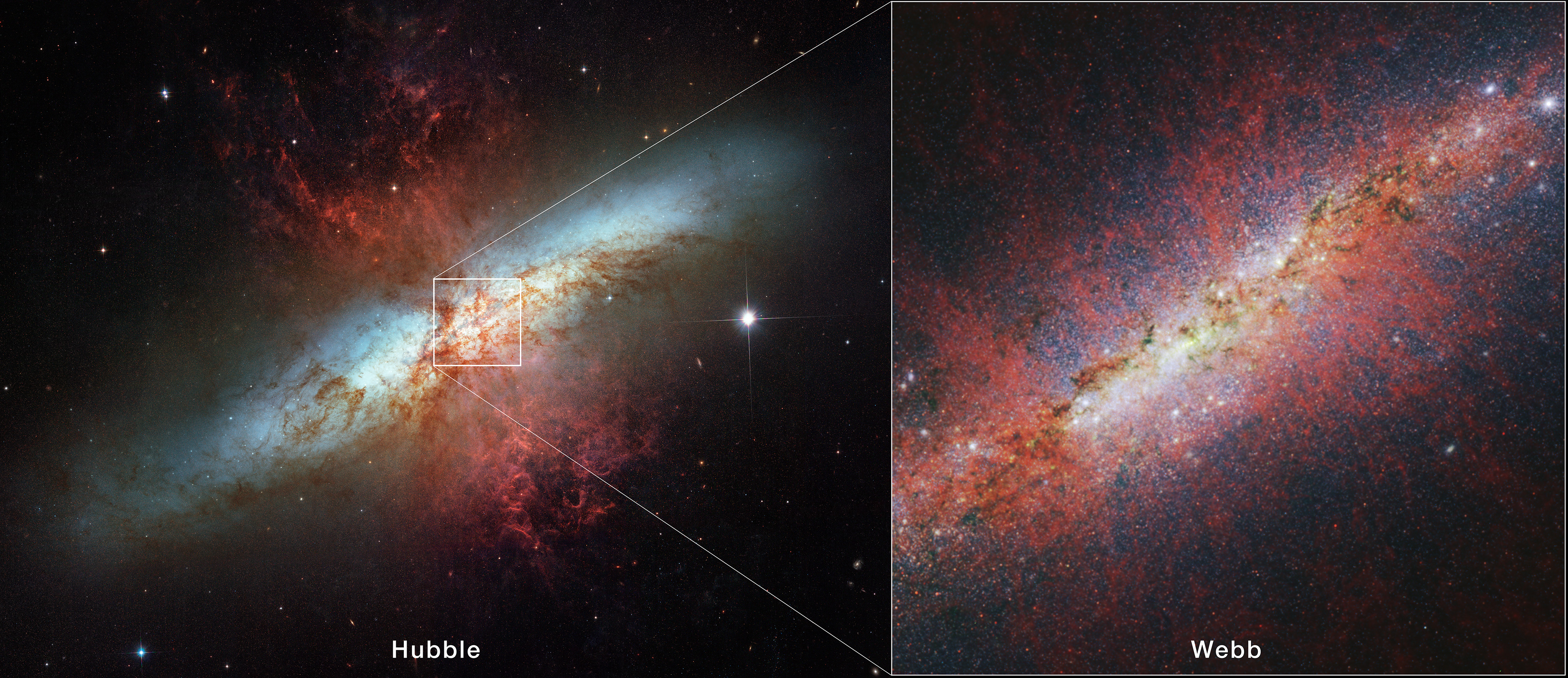
This image at a wavelength of 15 microns was taken by MIRI (the Mid-Infrared Instrument) on NASA’s James Webb Space...
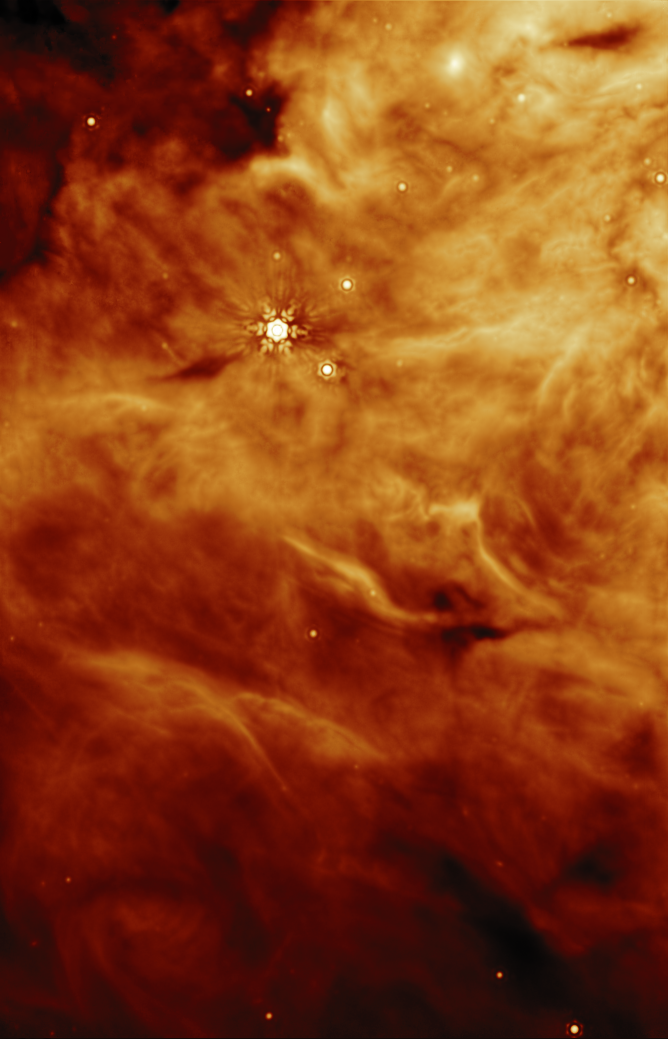
NASA’s James Webb Space Telescope’s MIRI (Mid-Infrared Instrument) has identified a variety of complex organic molecules that are present in...
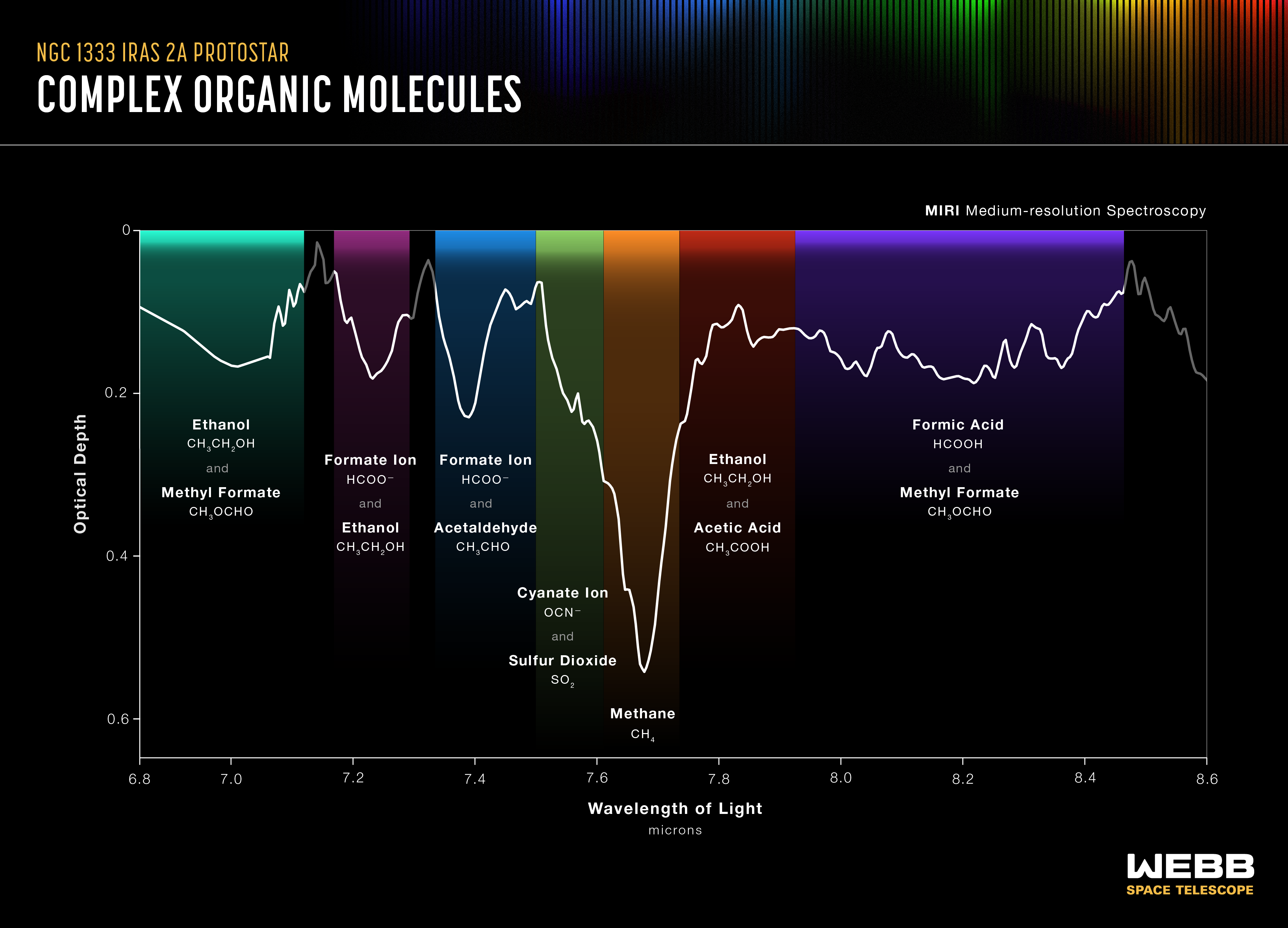
This image from NASA’s James Webb Space Telescope’s NIRCam (Near-Infrared Camera) of star-forming region NGC 604 shows how stellar winds...
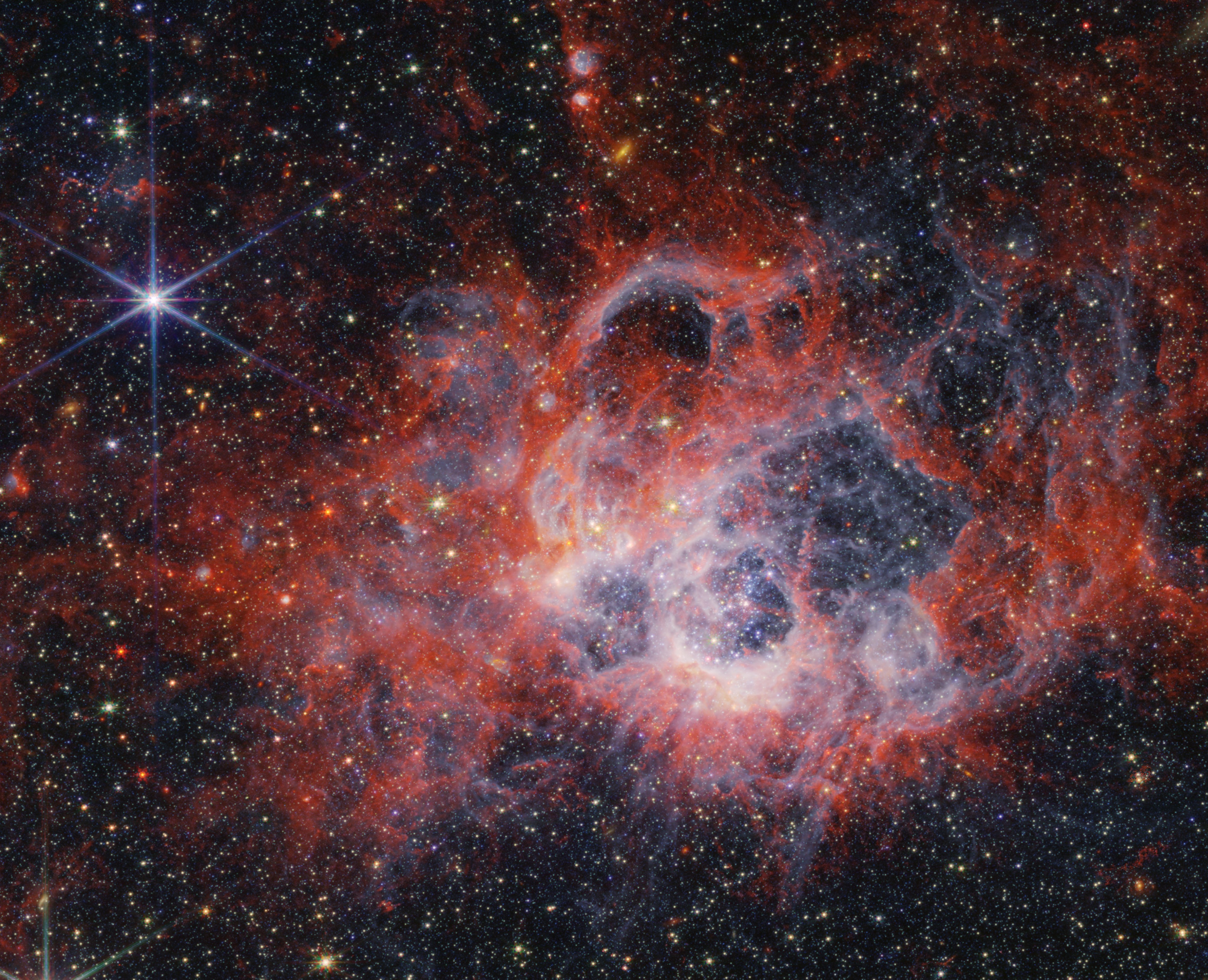
This image from NASA’s James Webb Space Telescope’s MIRI (Mid-Infrared Instrument) of star-forming region NGC 604 shows how large clouds...
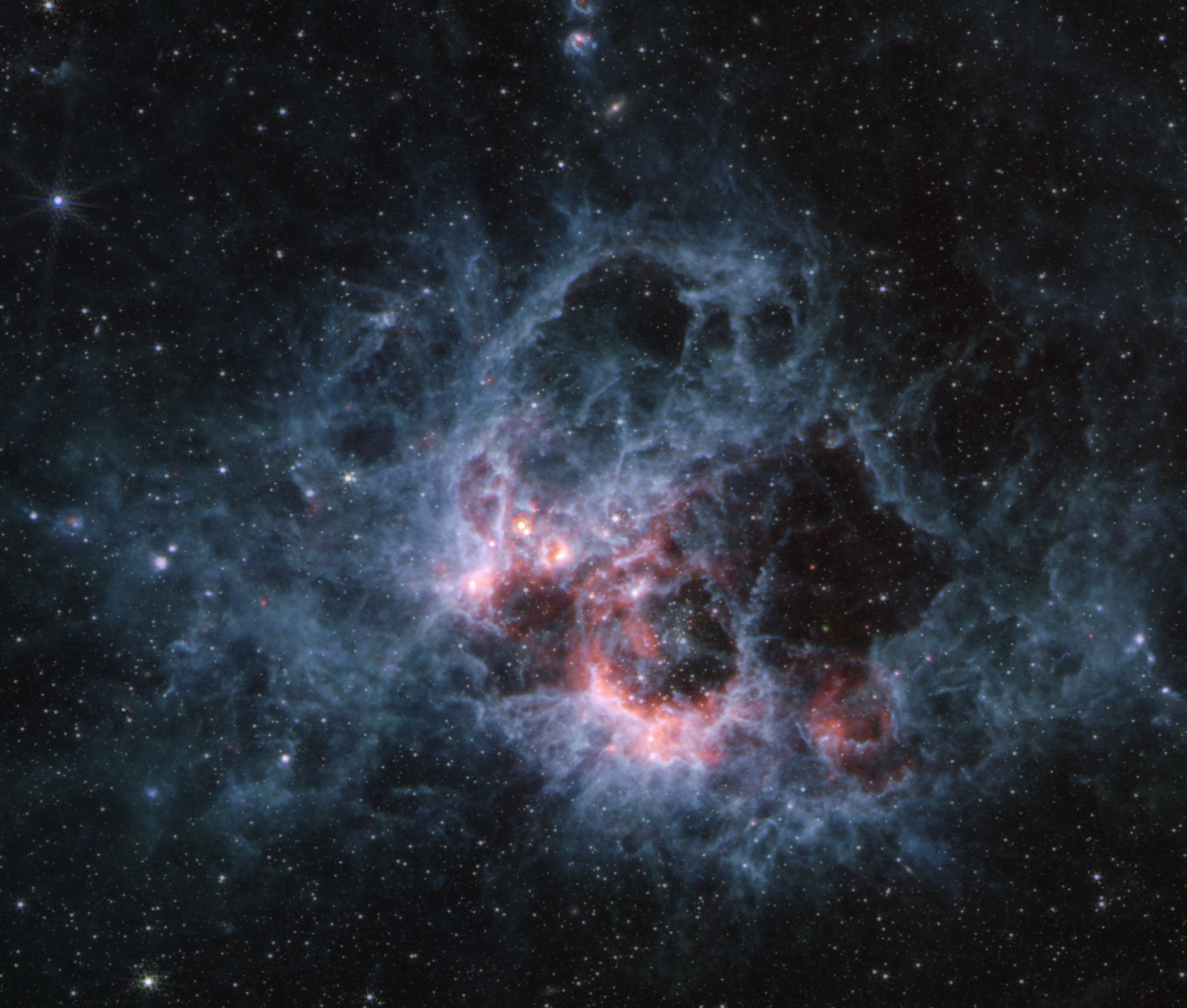
This image from NASA’s James Webb Space Telescope NIRCam (Near-Infrared Camera) instrument shows a portion of the GOODS-North field of...

This two-part graphic shows evidence of a gaseous clump of helium in the halo surrounding galaxy GN-z11. In the top...
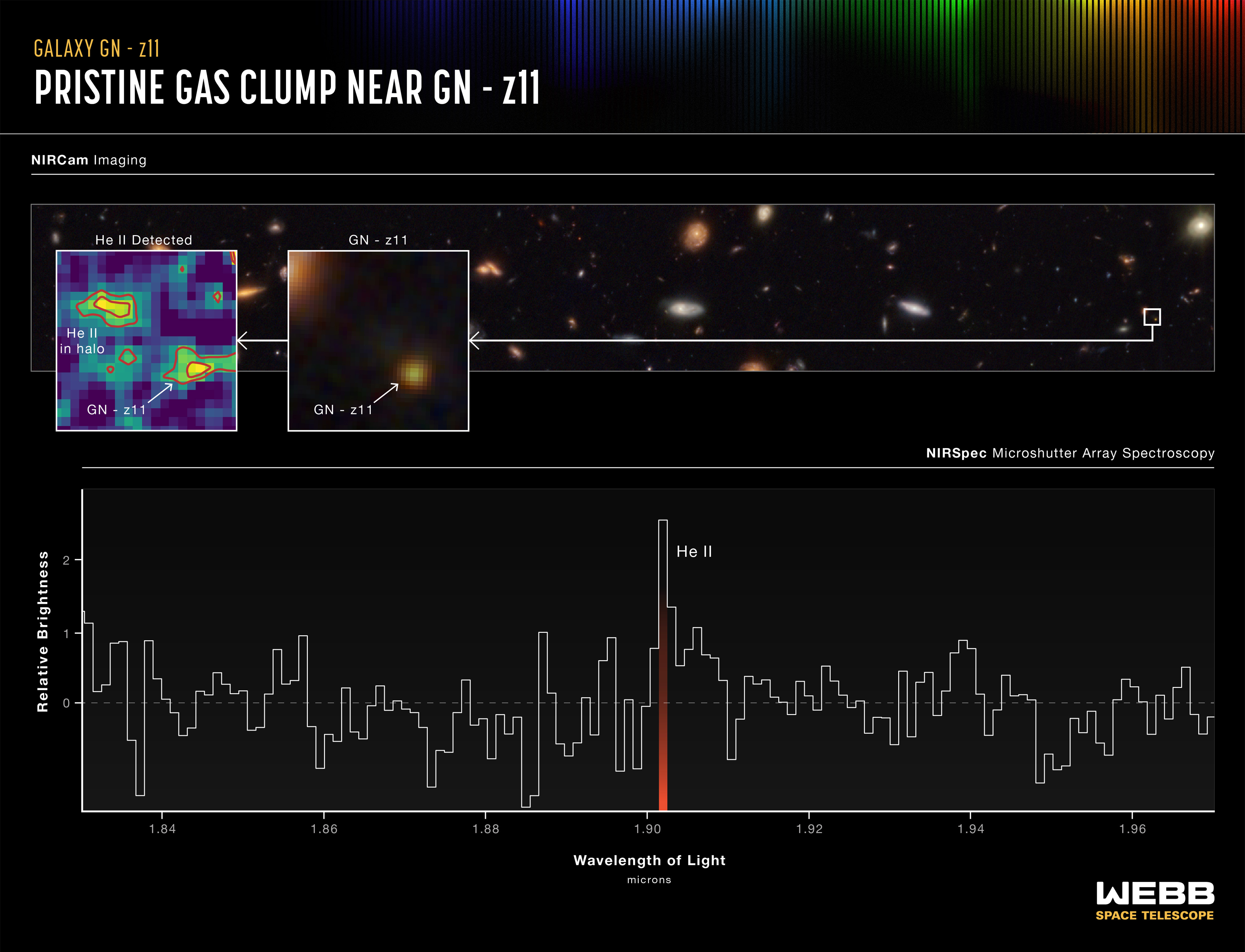
Video still frame from a sonification of the Southern Ring Nebula. Two views of the same object, the Southern Ring...
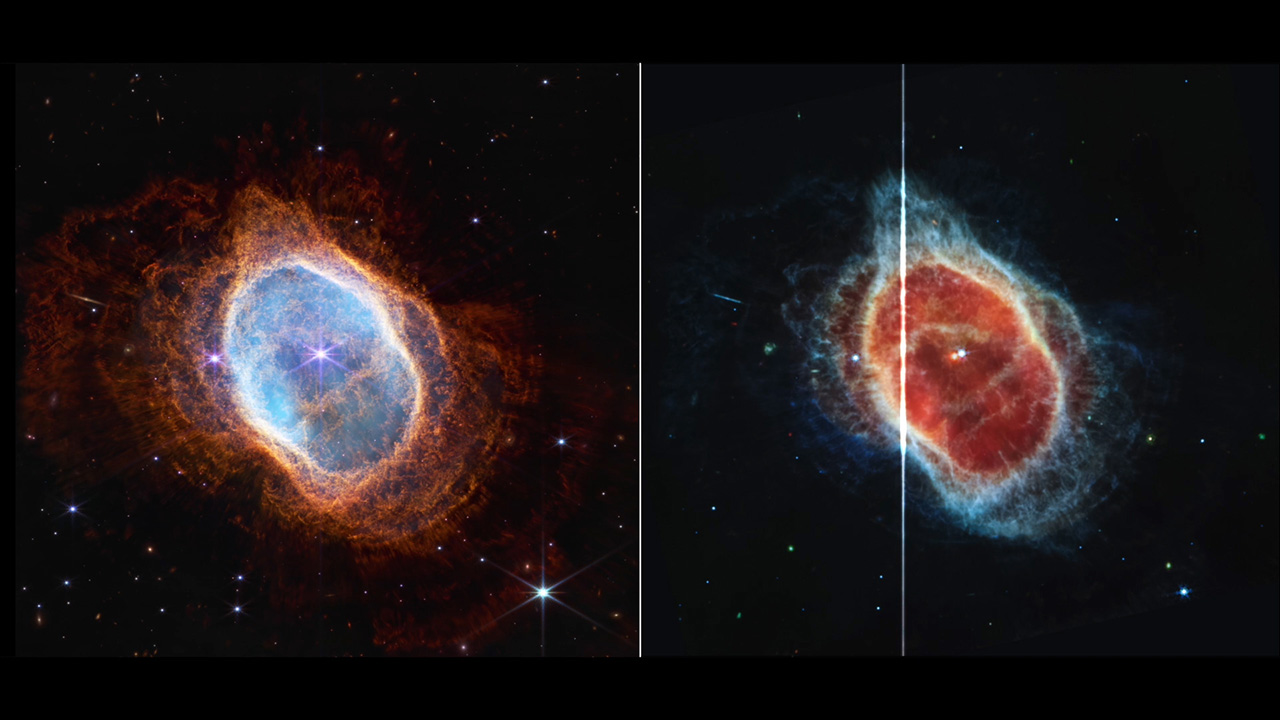
The James Webb Space Telescope has observed the best evidence yet for emission from a neutron star at the site...
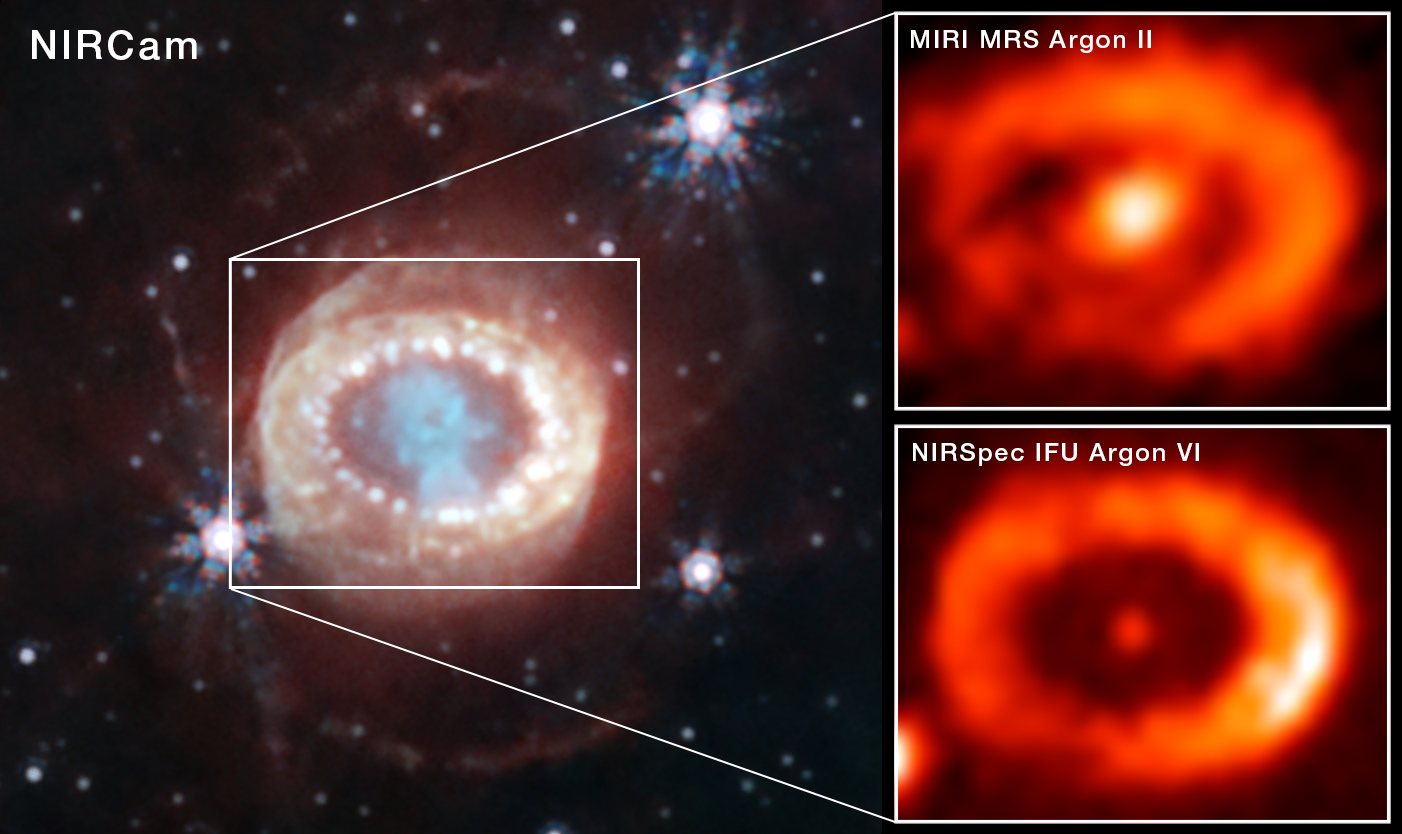
These are examples of distant galaxies captured by NASA’s James Webb Space Telescope in its CEERS Survey. Galaxies frequently appear...
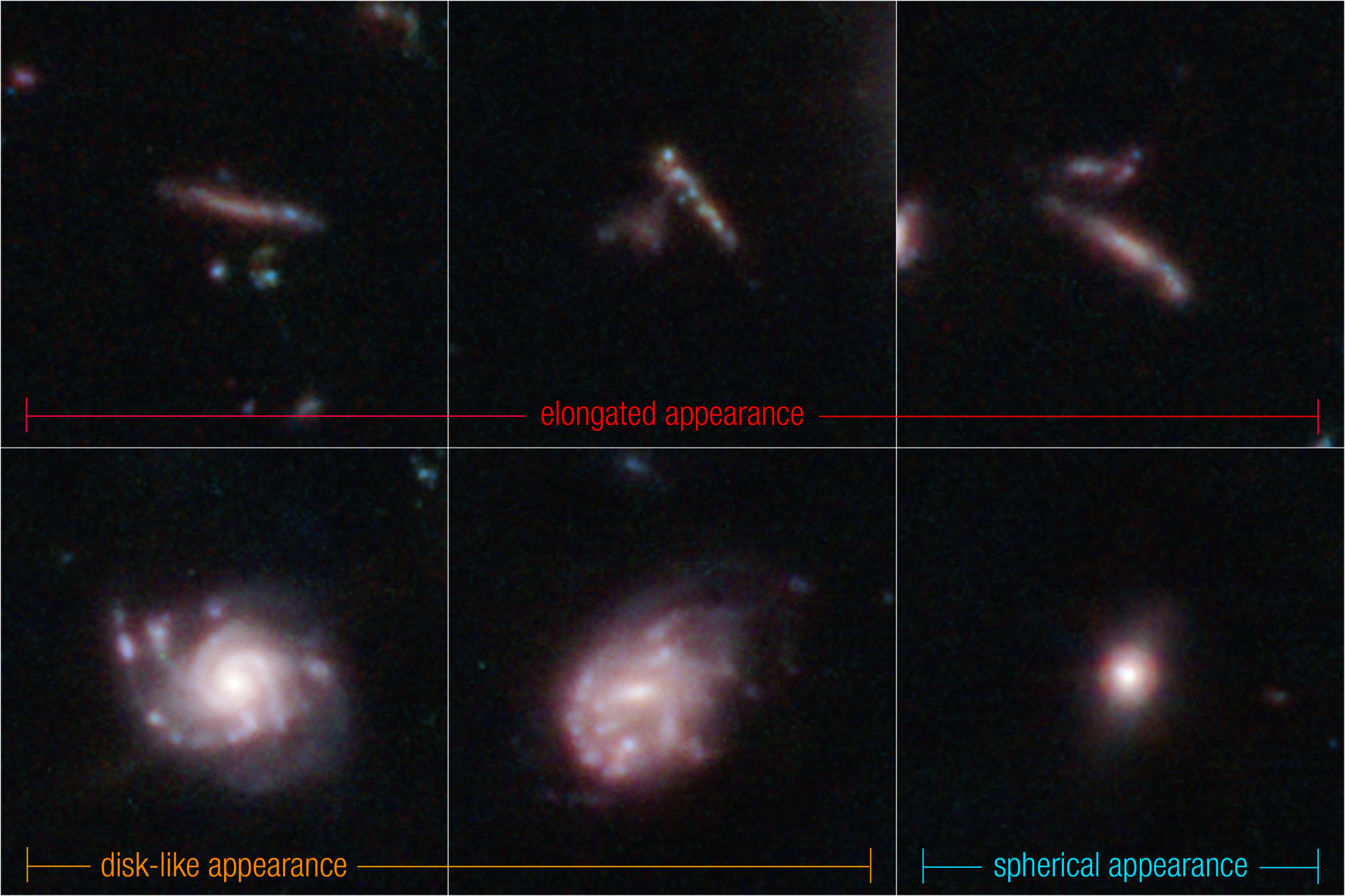
This is an animation portraying the creation of the cat’s tail, as hypothesized by a team of astronomers. The cat’s...
This image from Webb’s MIRI (Mid-Infrared Instrument) shows the star system Beta Pictoris. An edge-on disk of dusty debris generated...

Astronomers used NASA’s James Webb Space Telescope to study 12 cold brown dwarfs. Two of them – W1935 and W2220...

This artist concept portrays the brown dwarf W1935, which is located 47 light-years from Earth. Astronomers using NASA’s James Webb...
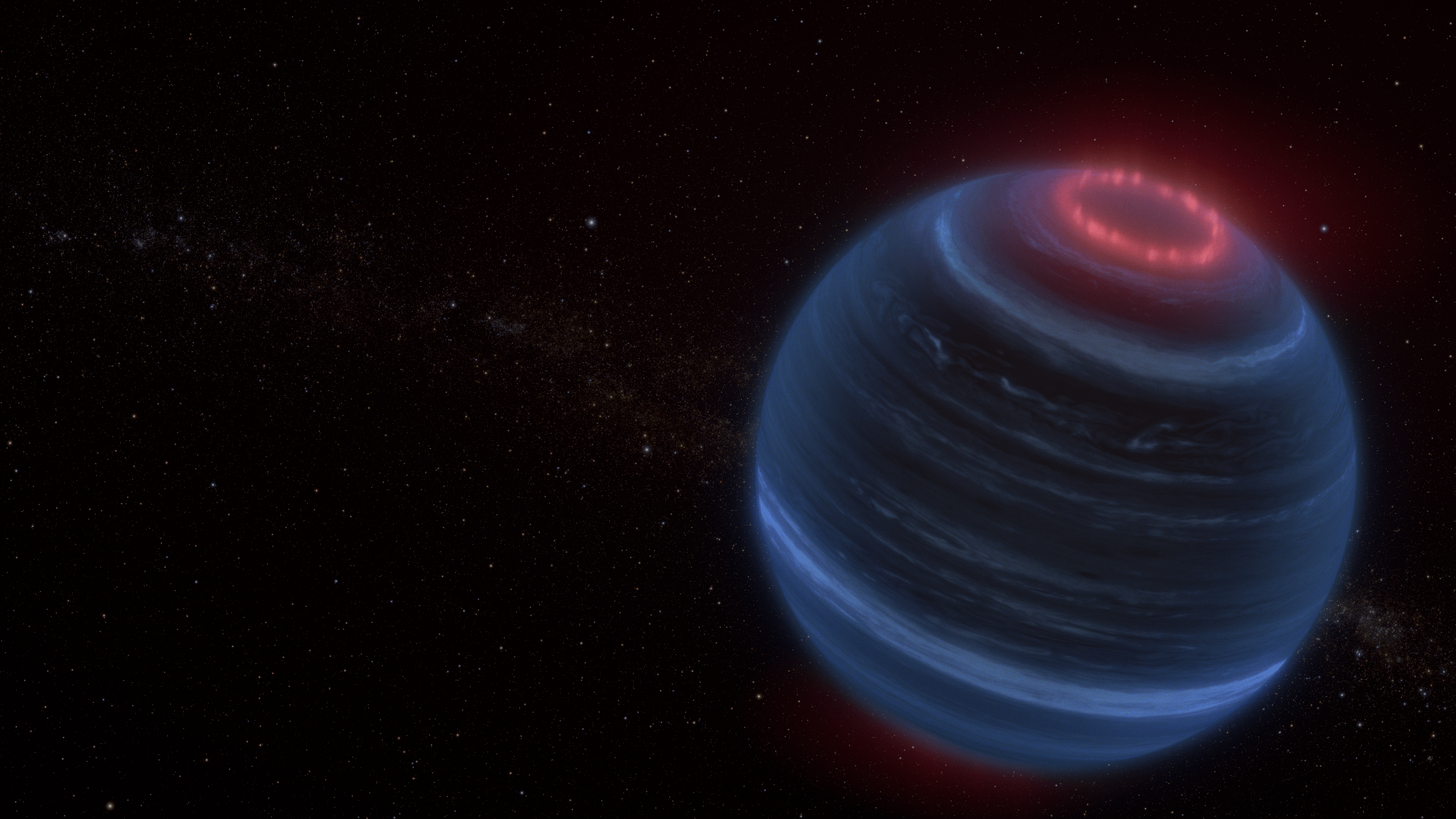
Webb Telescopes view face-on of spiral galaxy NGC 4254.

Spiral galaxy NGC 2835 is 35 million light-years away in the constellation Hydra.
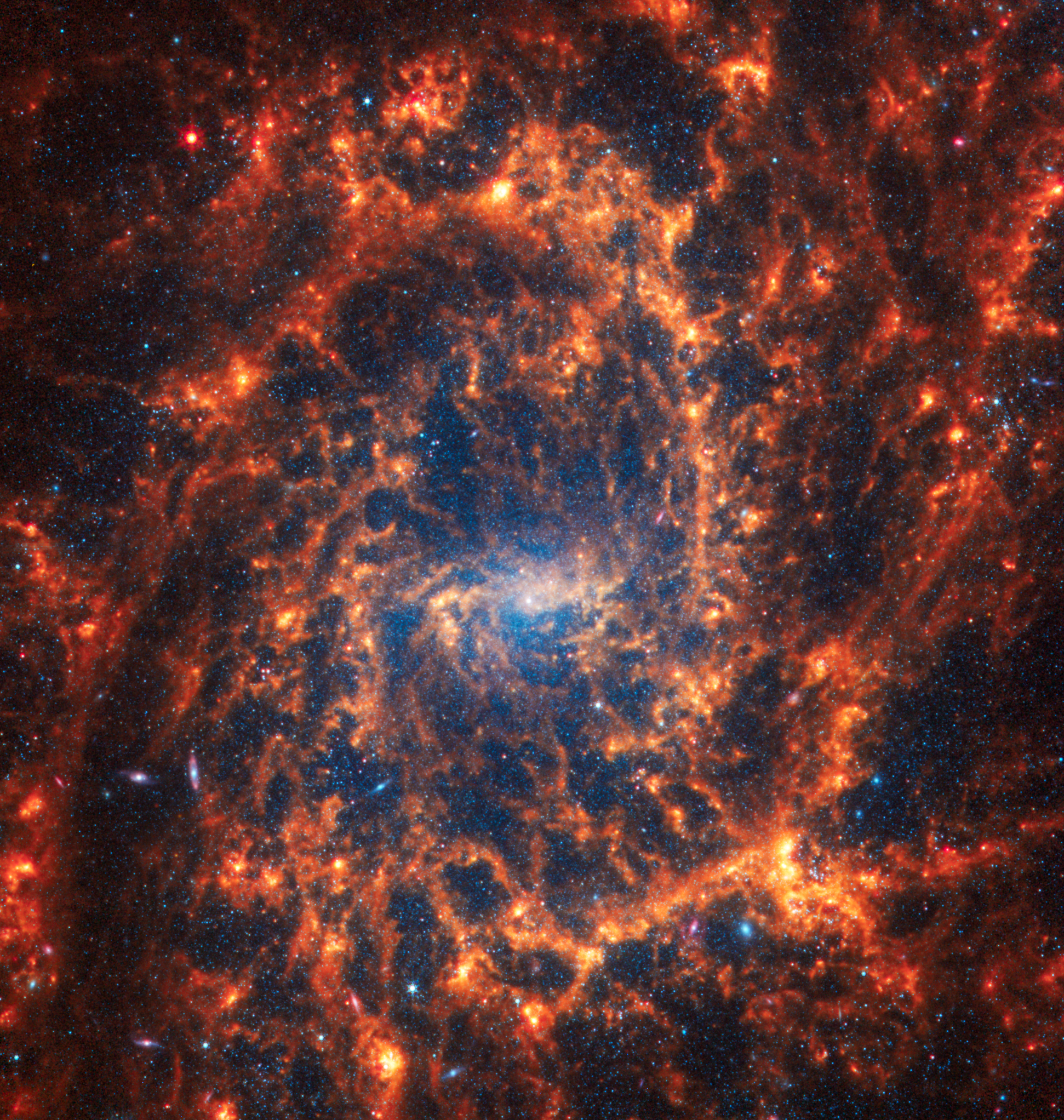
Spiral galaxy NGC 1672 is 60 million light-years away in the constellation Dorado.
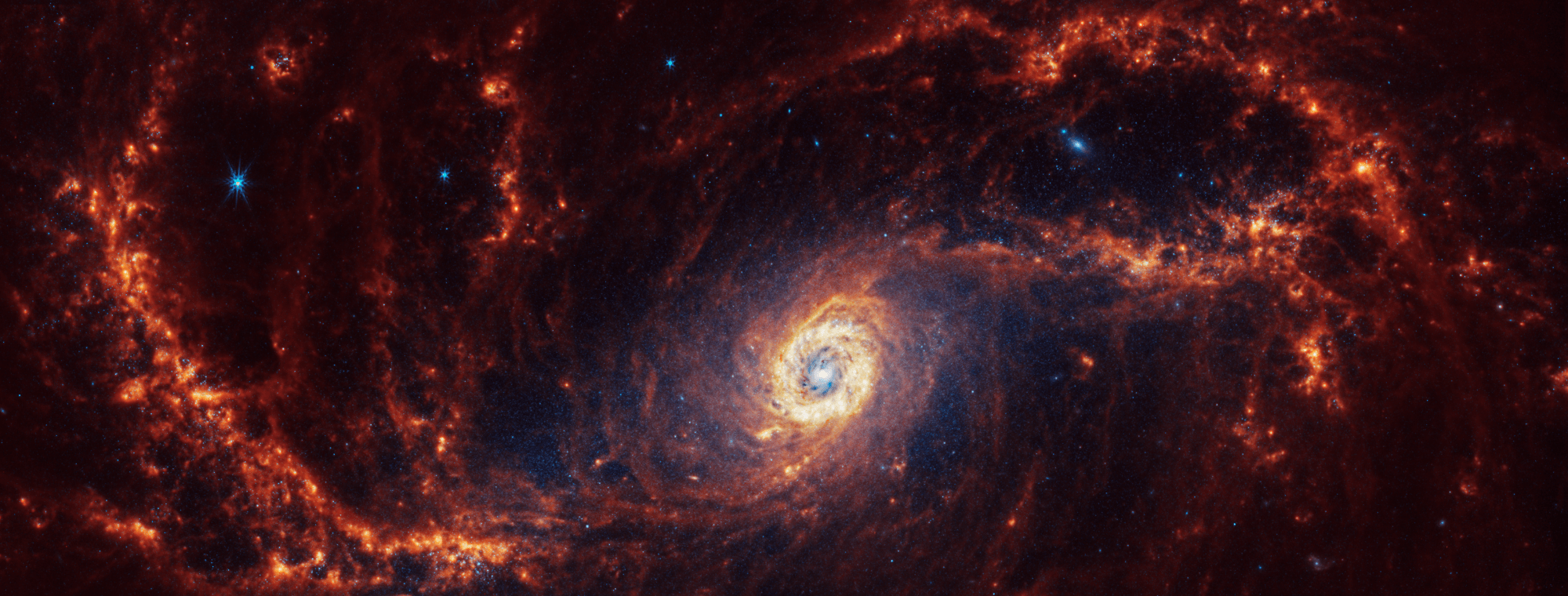
Spiral galaxy NGC 1566 is 60 million light-years away in the constellation Dorado.
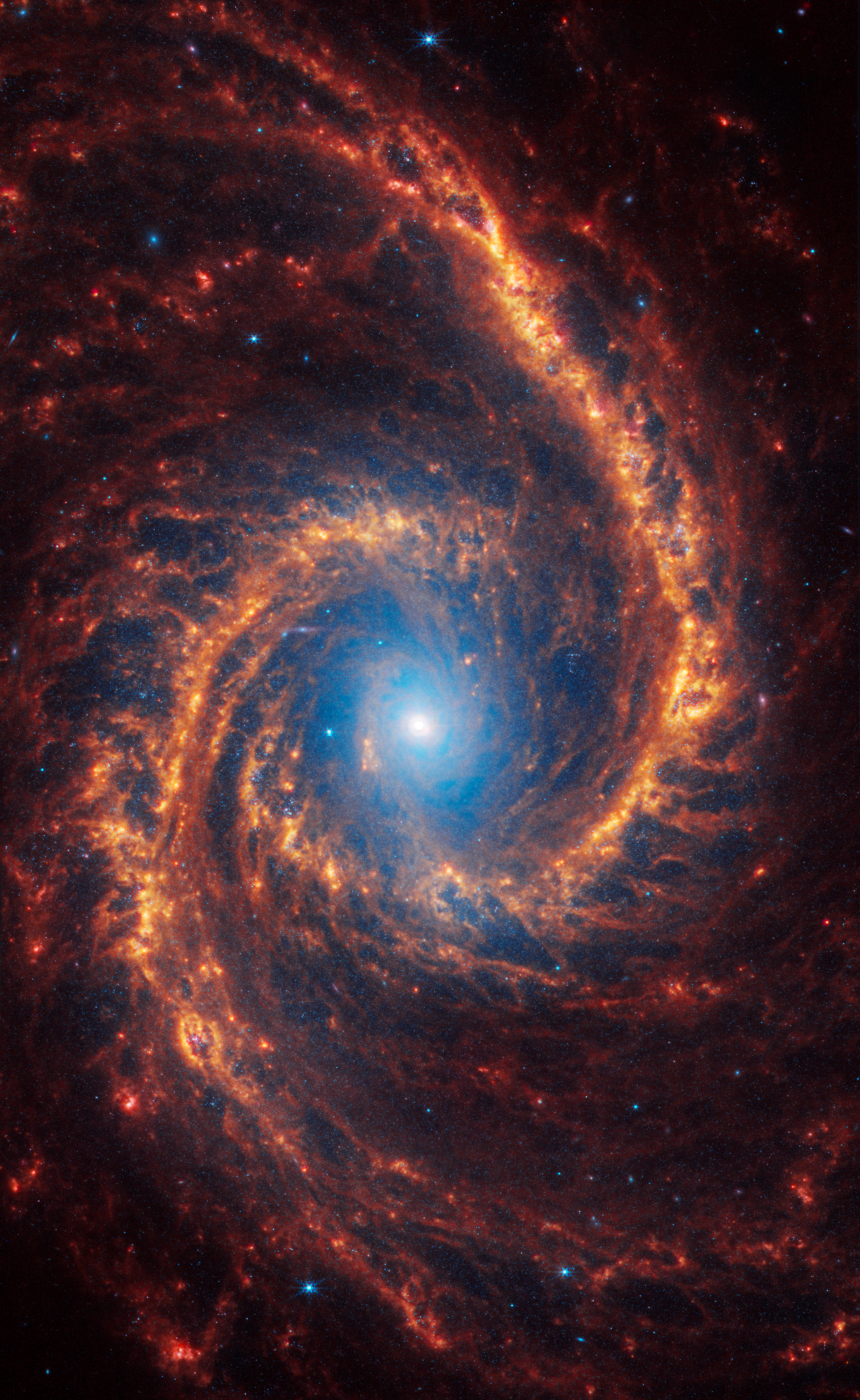
Spiral galaxy NGC 1512 is 30 million light-years away in the constellation Horologium.
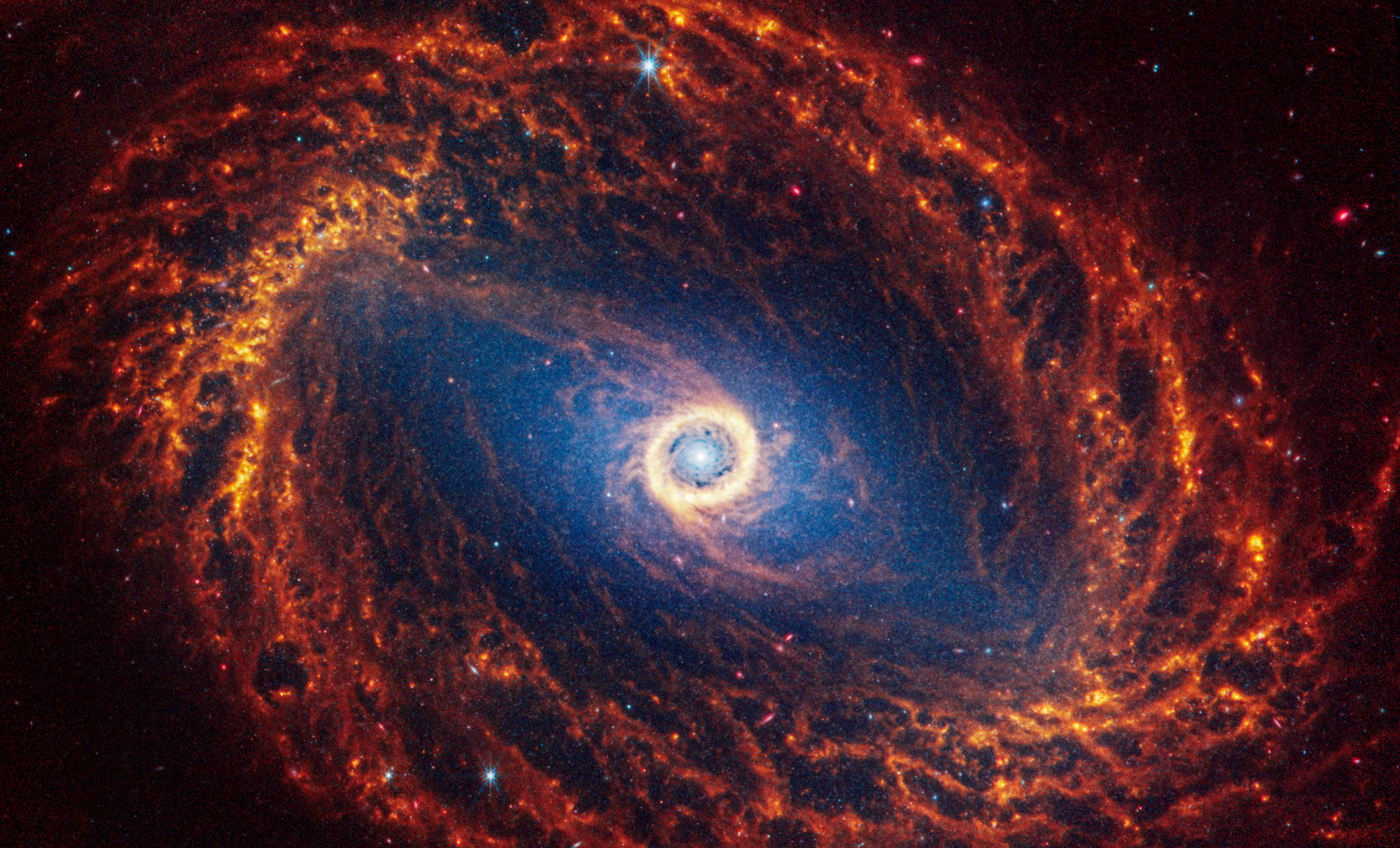
Spiral galaxy NGC 1385 is 30 million light-years away in the constellation Fornax.
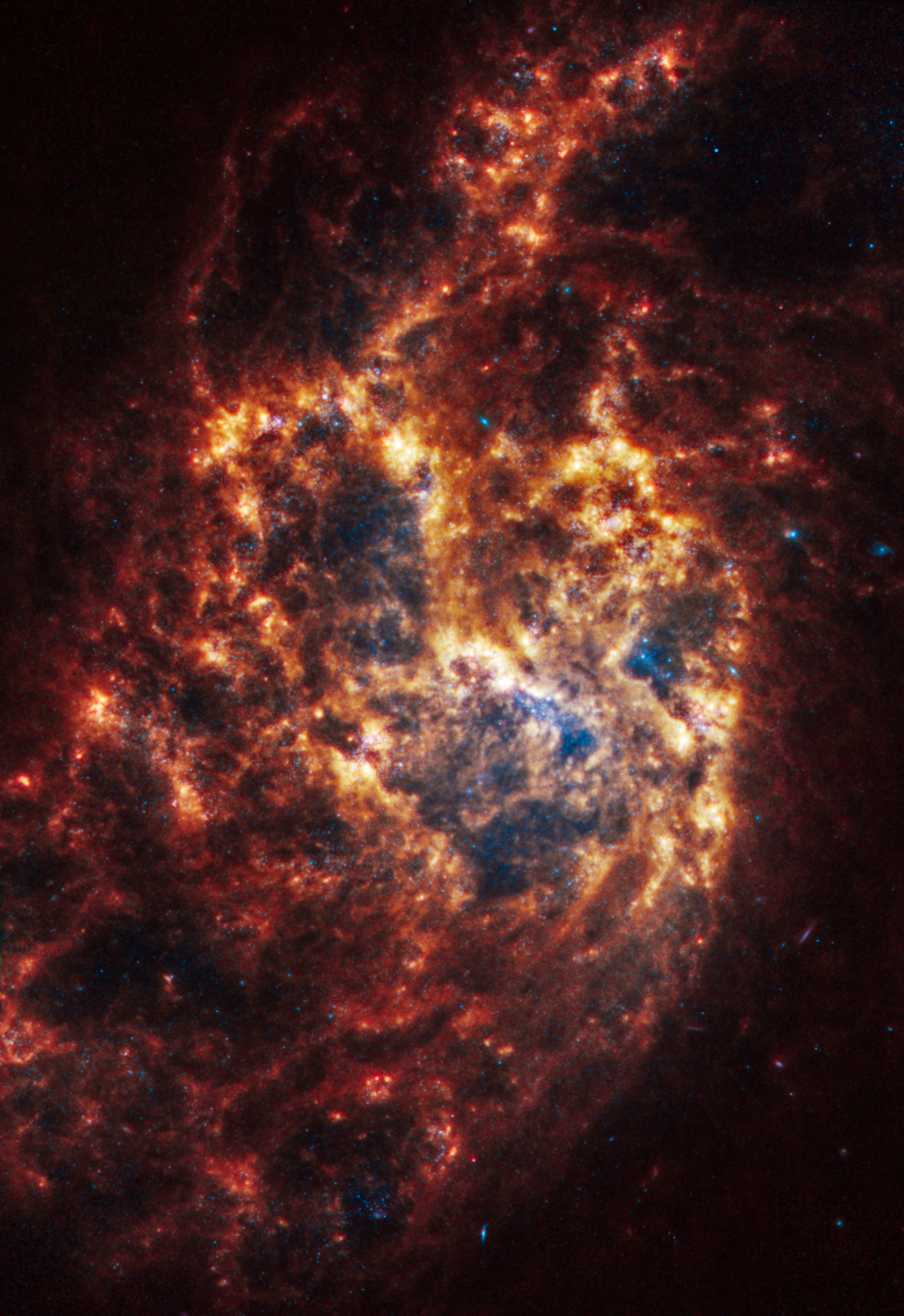
Spiral galaxy NGC 1300 is 69 million light-years away in the constellation Eridanus.
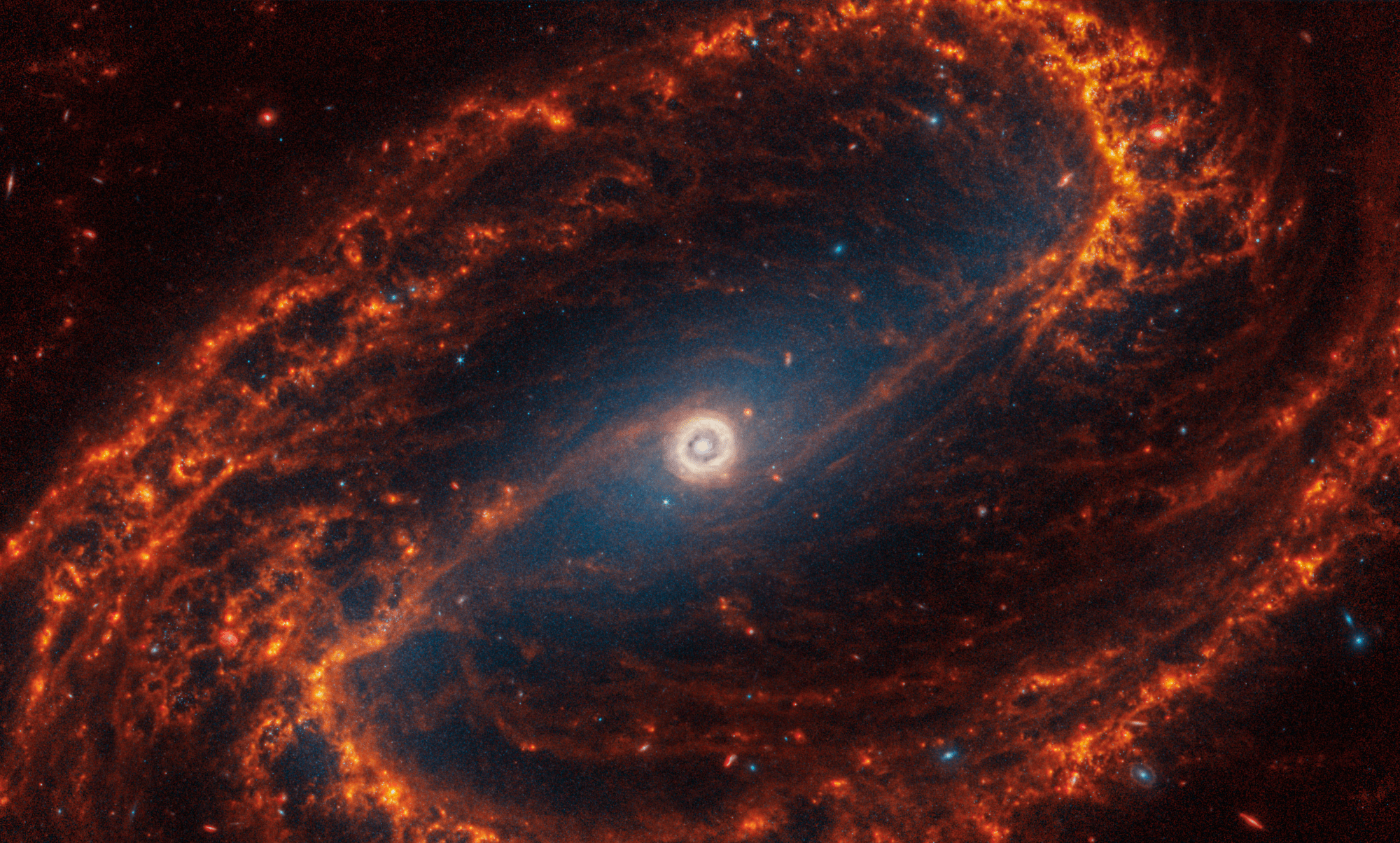
Spiral galaxy NGC 1087 is 80 million light-years away in the constellation Cetus.
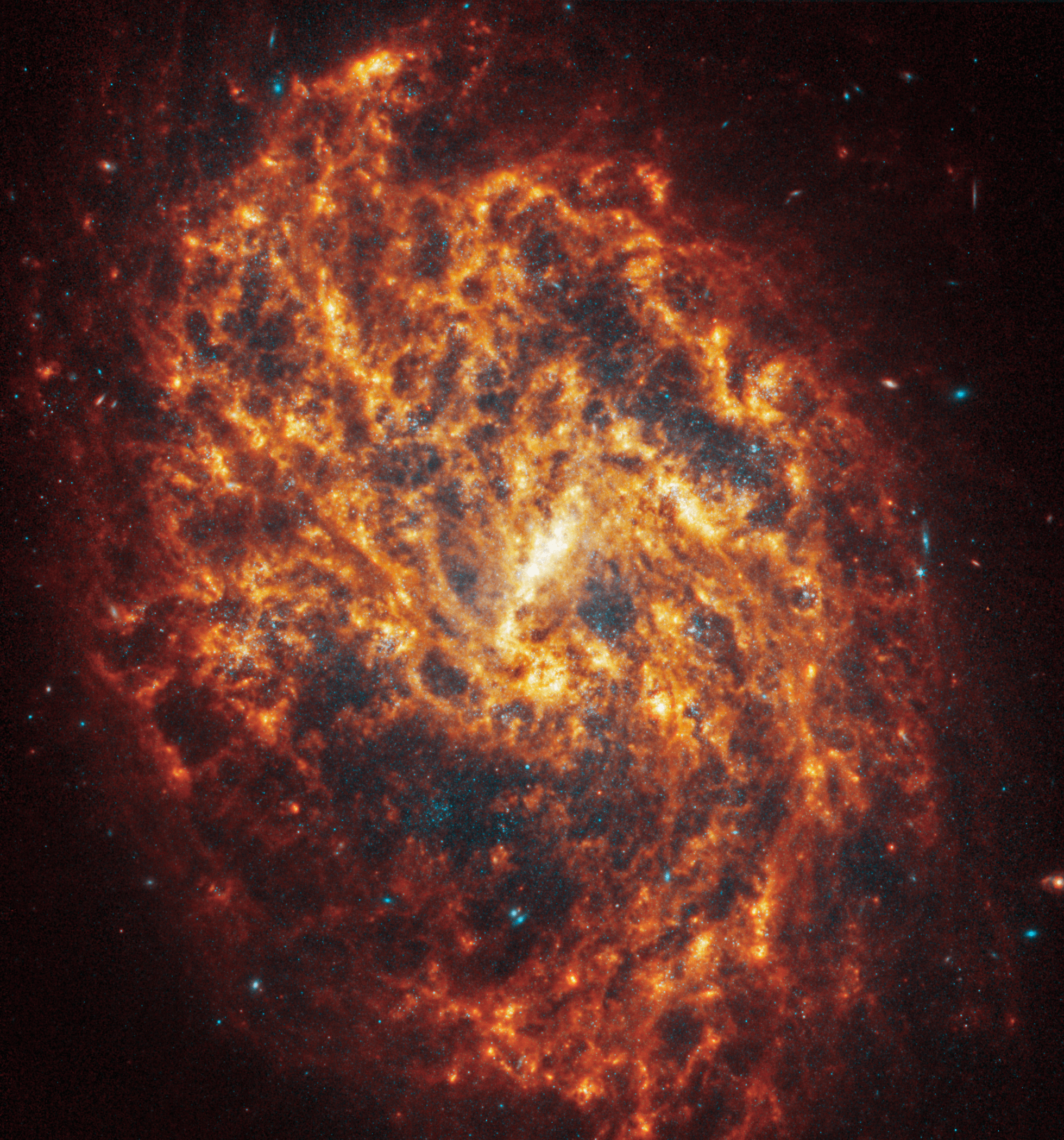
Face-on spiral galaxy, NGC 628, is split diagonally in this image: The James Webb Space Telescope’s observations appear at top...
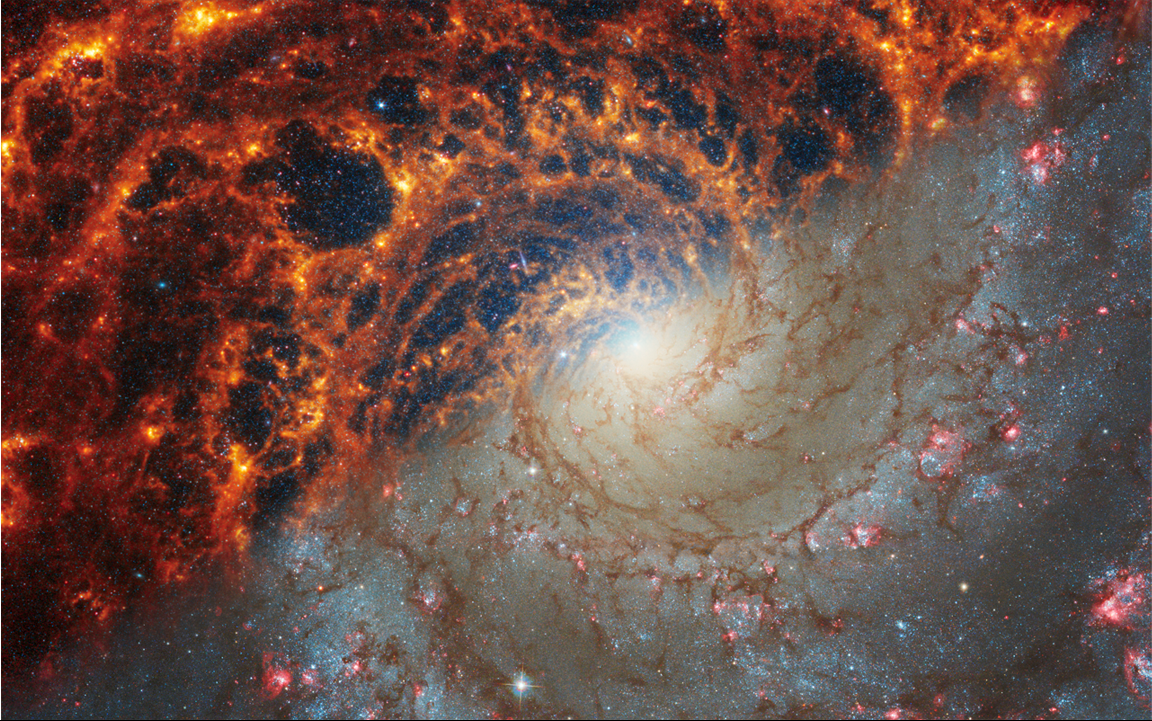
Spiral galaxy NGC 628 is 32 million light-years away in the constellation Pisces.
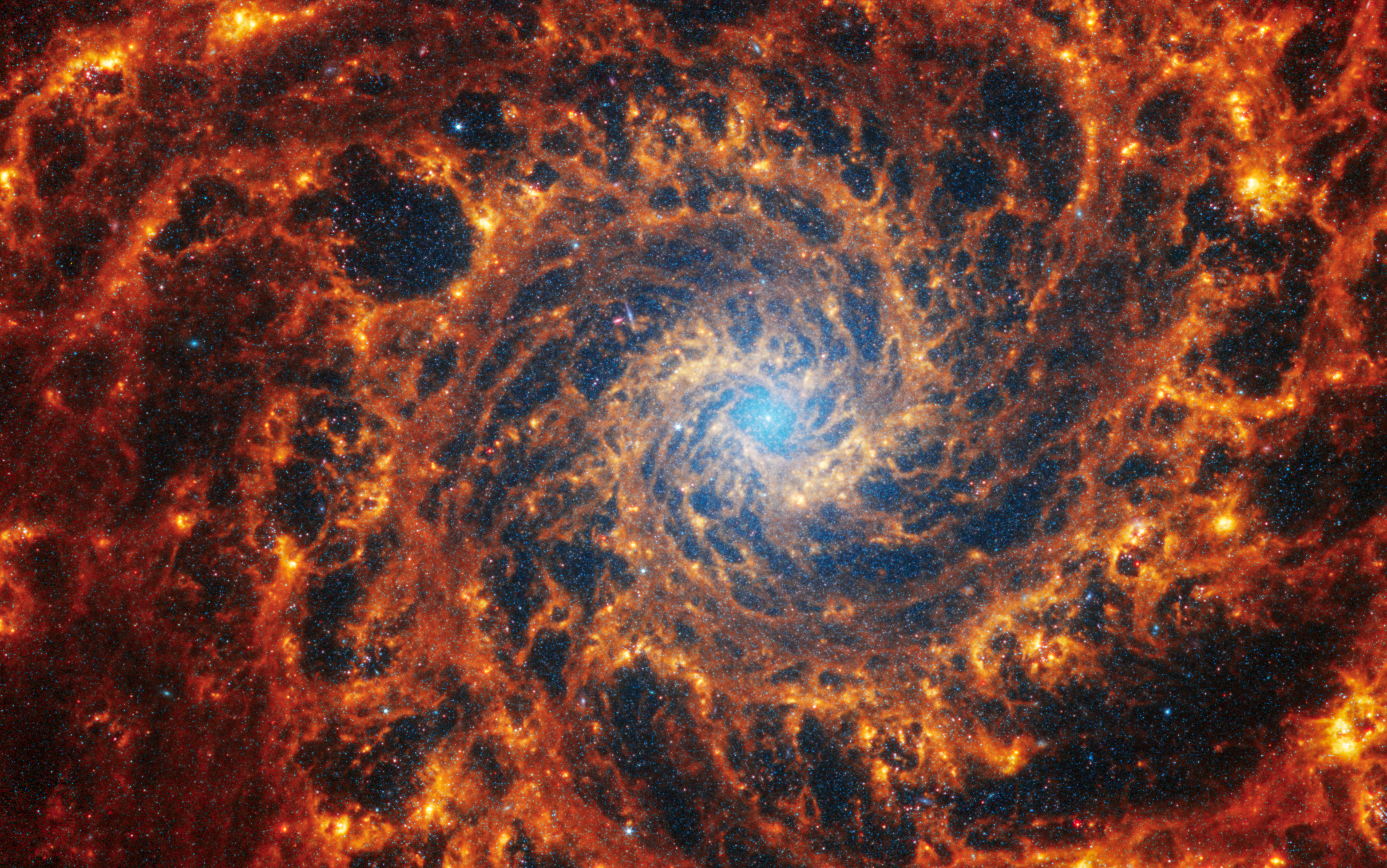
The James Webb Space Telescope observed 19 nearby face-on spiral galaxies in near- and mid-infrared light as part of its...
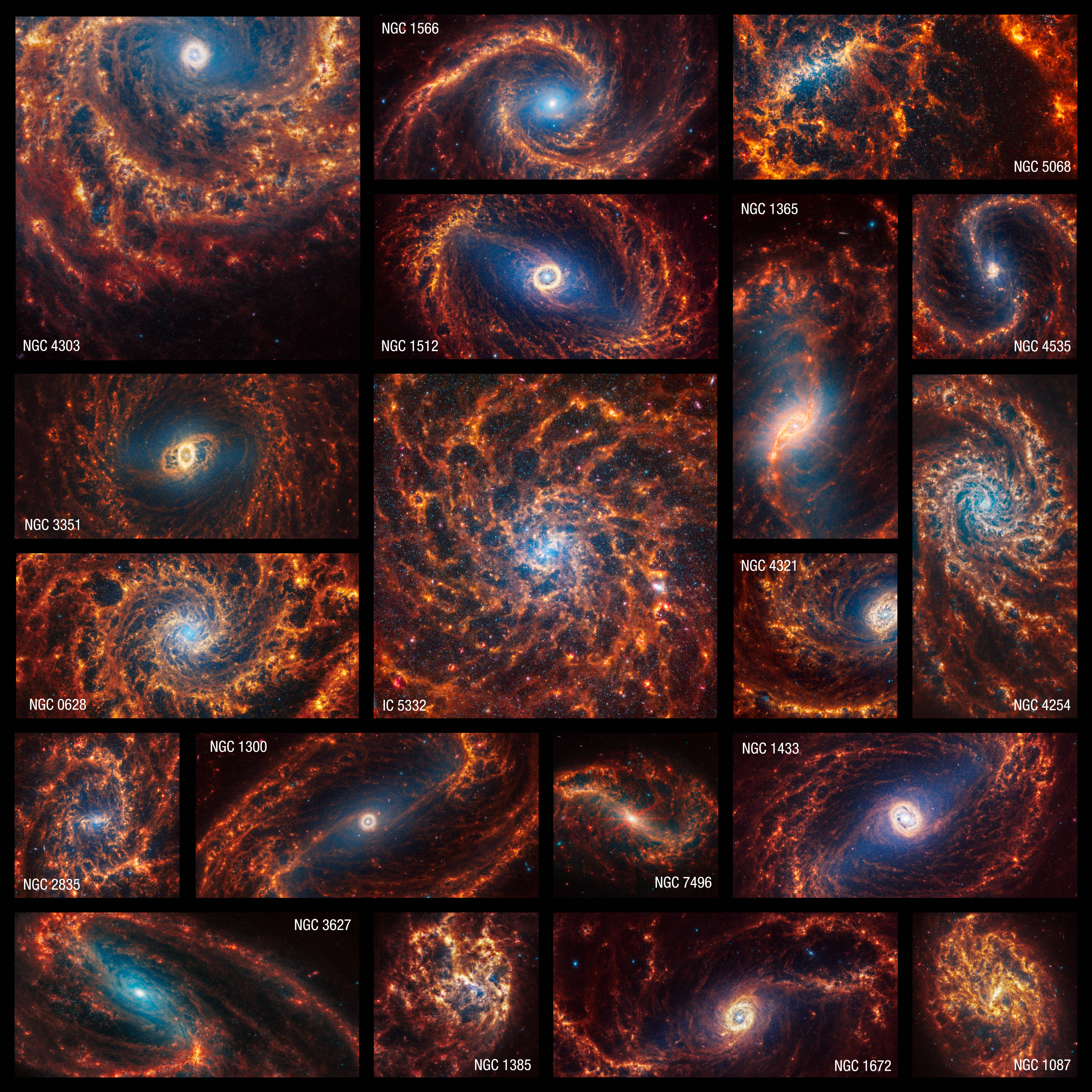
Researchers analyzing distant galaxies that show up in the Cosmic Evolution Early Release Science (CEERS) Survey from NASA’s James Webb...
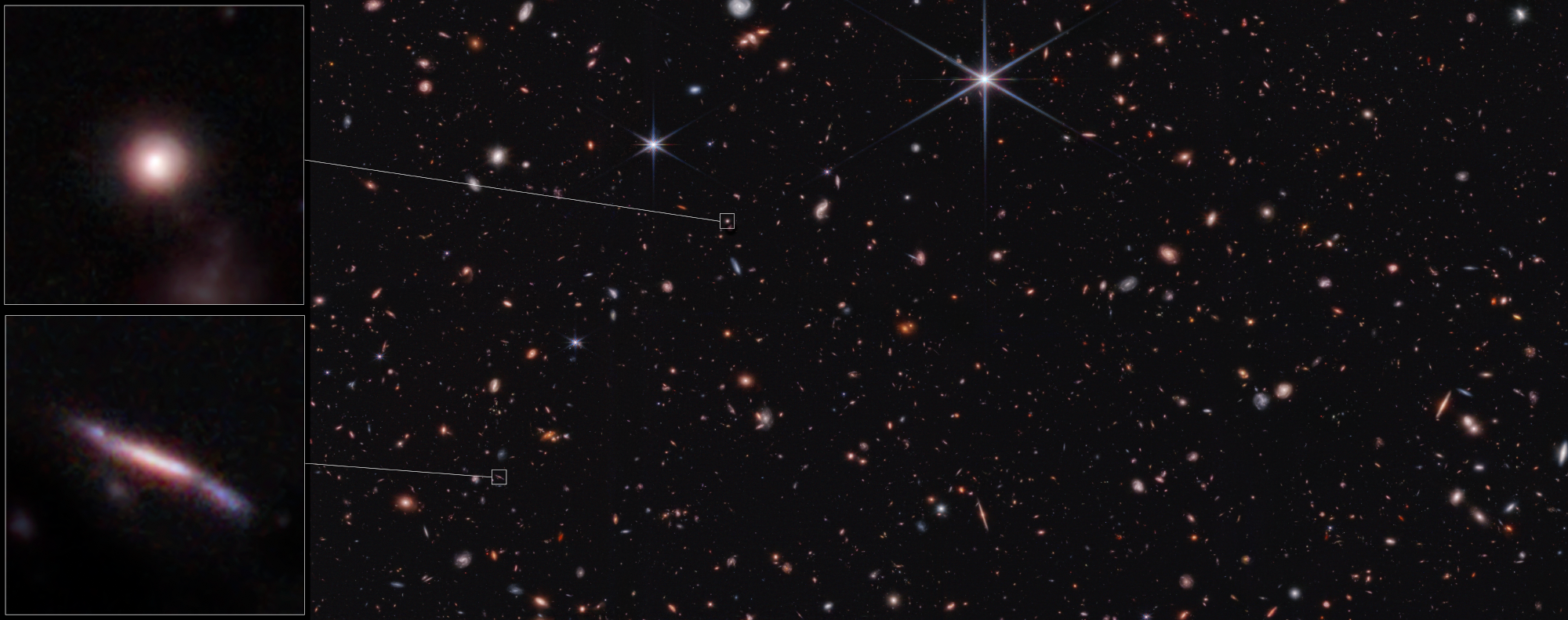
This panchromatic view of galaxy cluster MACS0416 was created by combining infrared observations from NASA’s James Webb Space Telescope with...
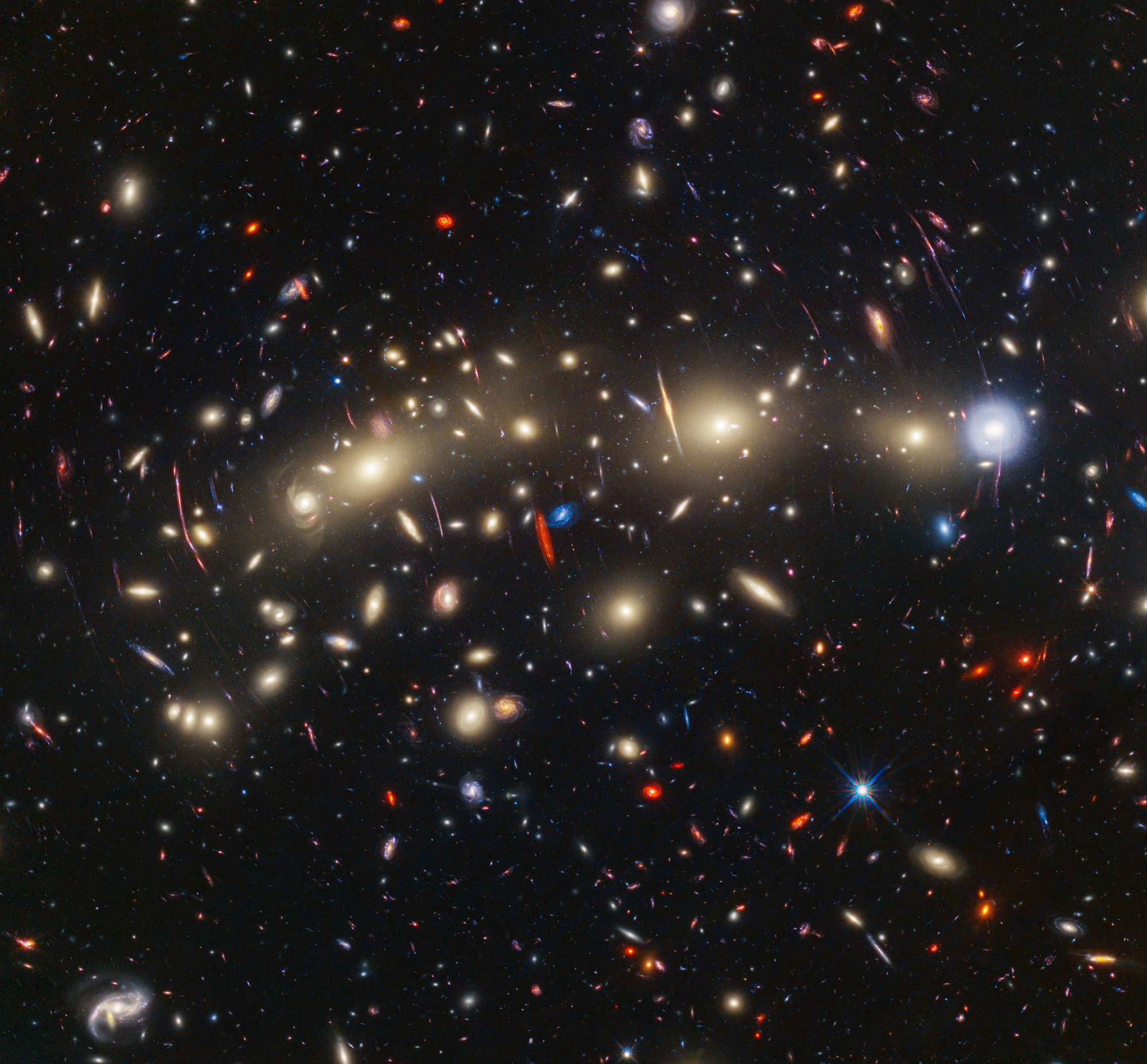
This image from Webb’s MIRI (Mid-Infrared Instrument) shows the star system Beta Pictoris. An edge-on disk of dusty debris generated...
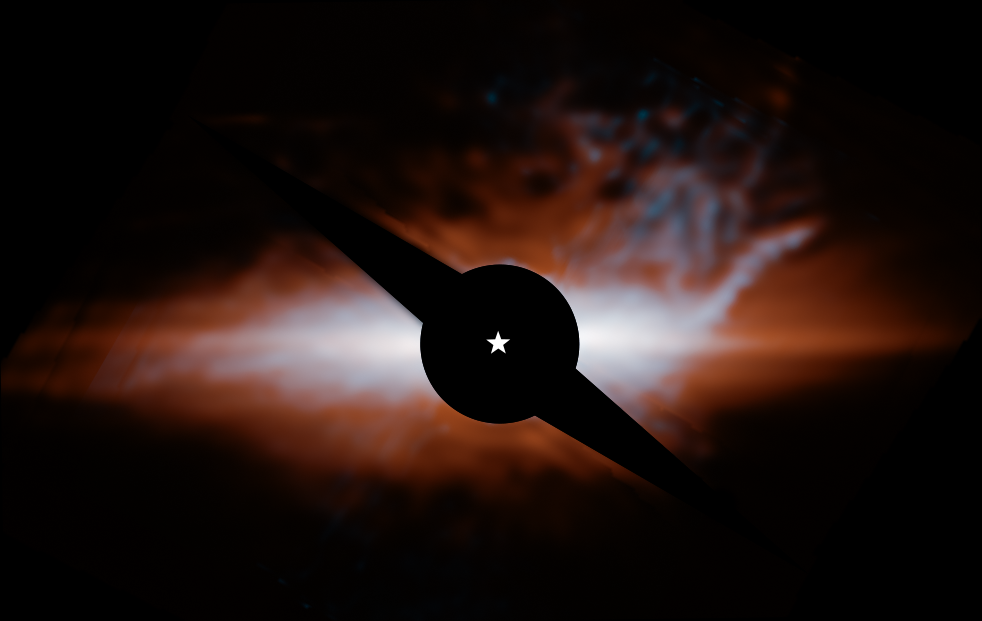
This artist concept portrays the brown dwarf W1935, which is located 47 light-years from Earth. Astronomers using NASA’s James Webb...

This wide-field image of Uranus from NIRCam (Near-Infrared Camera) on NASA’s James Webb Space Telescope shows the planet amid a...
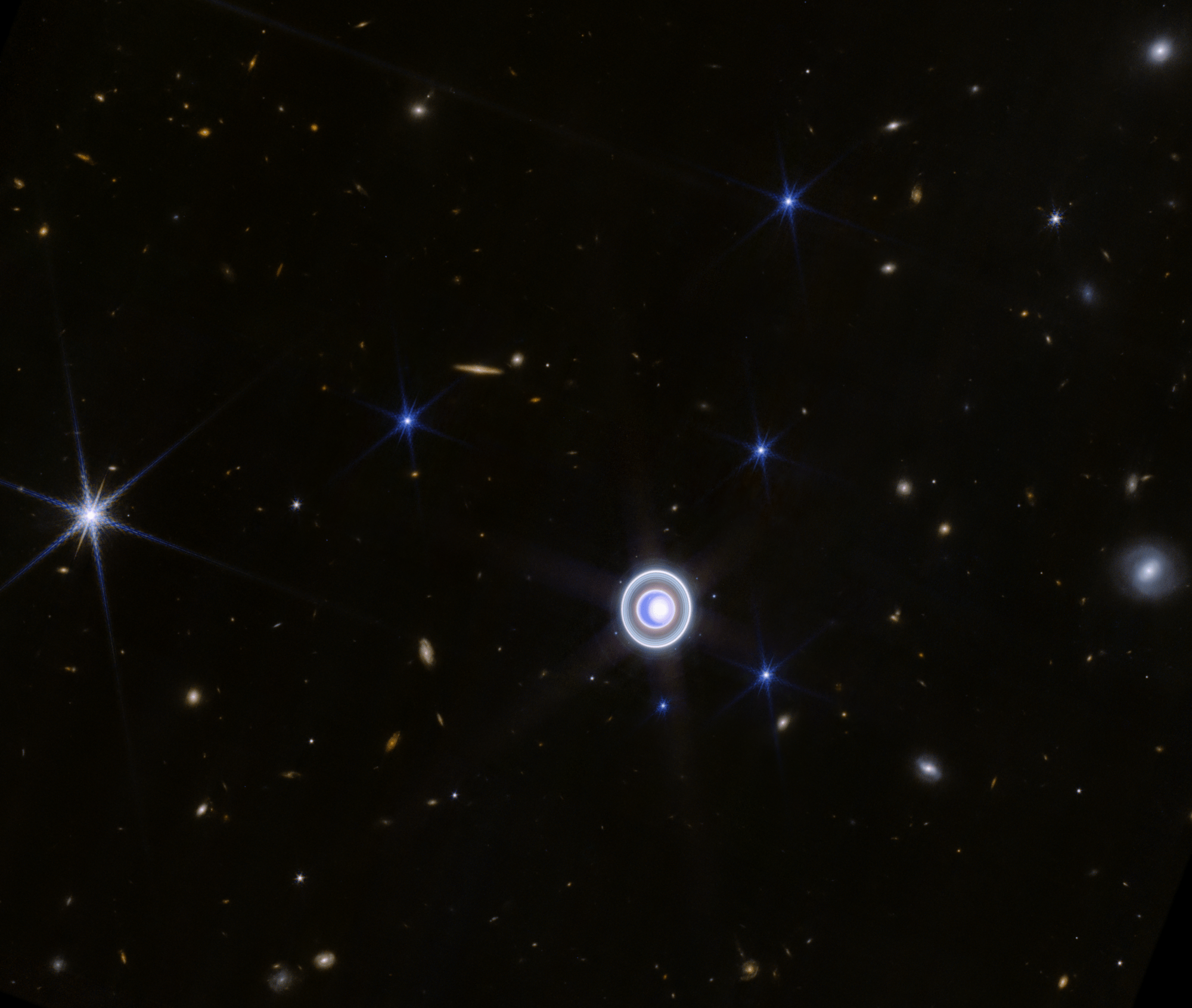
This image from the NIRCam (Near-Infrared Camera) instrument on NASA’s James Webb Space Telescope shows the central portion of the...

NASA’s James Webb Space Telescope’s new view of Cassiopeia A (Cas A) in near-infrared light is giving astronomers hints at...

This is an artist’s impression of a young star surrounded by a protoplanetary disk in which planets are forming.

The NIRCam (Near-Infrared Camera) instrument on NASA’s James Webb Space Telescope’s reveals a portion of the Milky Way’s dense center...

In this artist concept, the young star SZ Chamaeleontis (SZ Cha) is surrounded by a disk of dust and gas...

Artist's Concept: This artist’s concept compares two types of typical, planet-forming disks around newborn, Sun-like stars. On the left is...

This image by NASA’s James Webb Space Telescope’s NIRCam (Near-Infrared Camera) and MIRI (Mid-Infrared Instrument) reveals new details in infrared...

This image from NASA’s James Webb Space Telescope NIRCam (Near-Infrared Camera) instrument highlights Gamma-Ray Burst (GRB) 230307A and its associated...

This image of Jupiter from NASA’s James Webb Space Telescope’s NIRCam (Near-Infrared Camera) shows stunning details of the majestic planet...

ILLUSTRATION: This artist’s concept shows what the hot gas giant exoplanet WASP-17 b could look like based on observations from...

This new infrared image of NGC 346 from NASA’s James Webb Space Telescope’s Mid-Infrared Instrument (MIRI) traces emission from cool...

For as long as humans have gazed into the night sky, we have wondered about life beyond the Earth. Scientists...

NASA’s James Webb Space Telescope’s high resolution, near-infrared look at Herbig-Haro 211 reveals exquisite detail of the outflow of a...
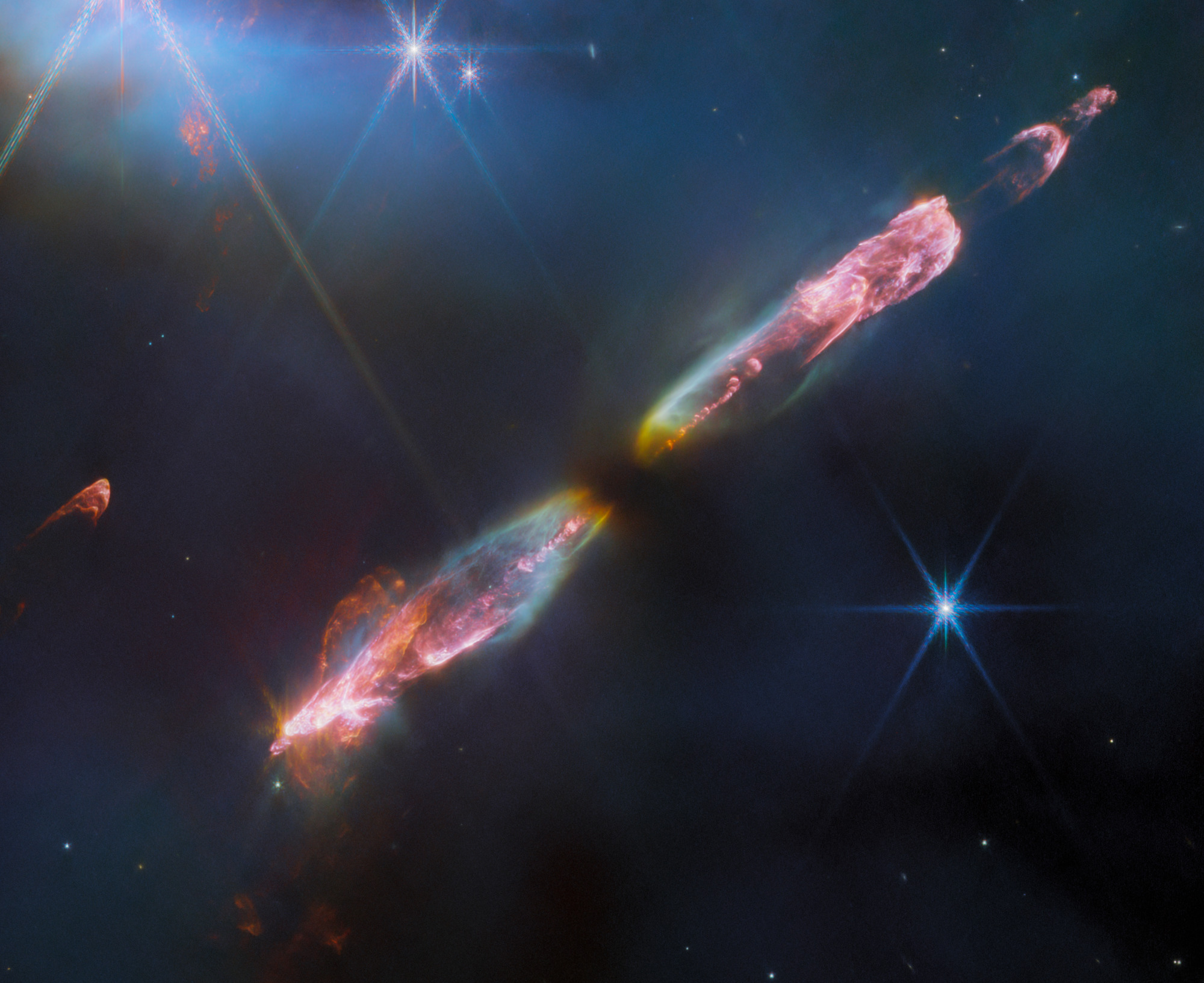
This artist’s concept shows what exoplanet K2-18 b could look like based on science data. K2-18 b, an exoplanet 8.6...
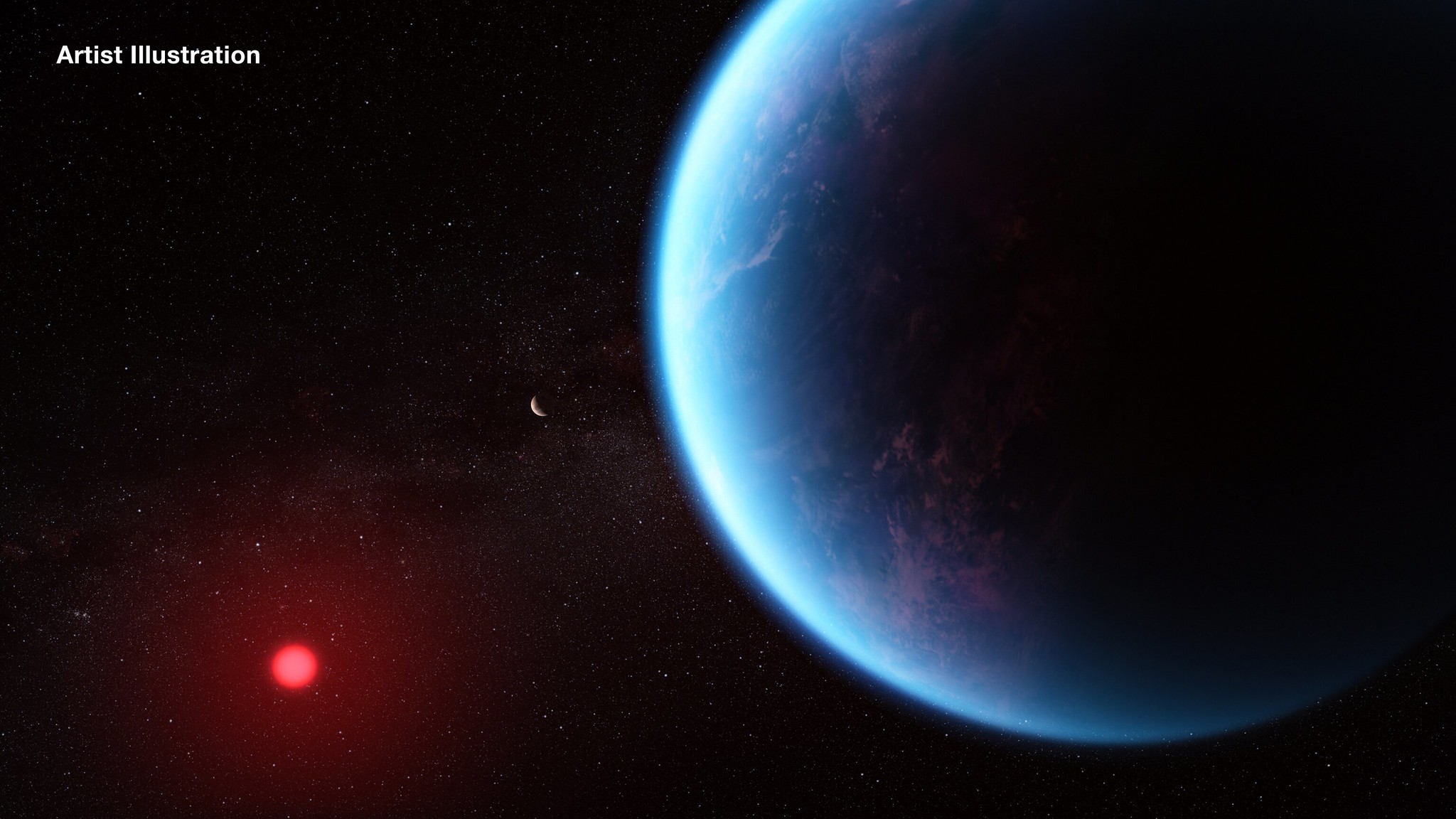
Webb’s NIRCam (Near-Infrared Camera) captured this detailed image of SN 1987A (Supernova 1987A). At the center, material ejected from the...

The NASA/ESA/CSA James Webb Space Telescope has observed the well-known Ring Nebula with unprecedented detail. Formed by a star throwing...

Webb’s infrared image of the galaxy cluster El Gordo (“the Fat One”) reveals hundreds of galaxies, some never before seen...

NASA’s James Webb Space Telescope has captured a tightly bound pair of actively forming stars, known as Herbig-Haro 46/47, in...

A wide field view showcases Jupiter in the upper right quadrant. The planet’s swirling horizontal stripes are rendered in blues,...
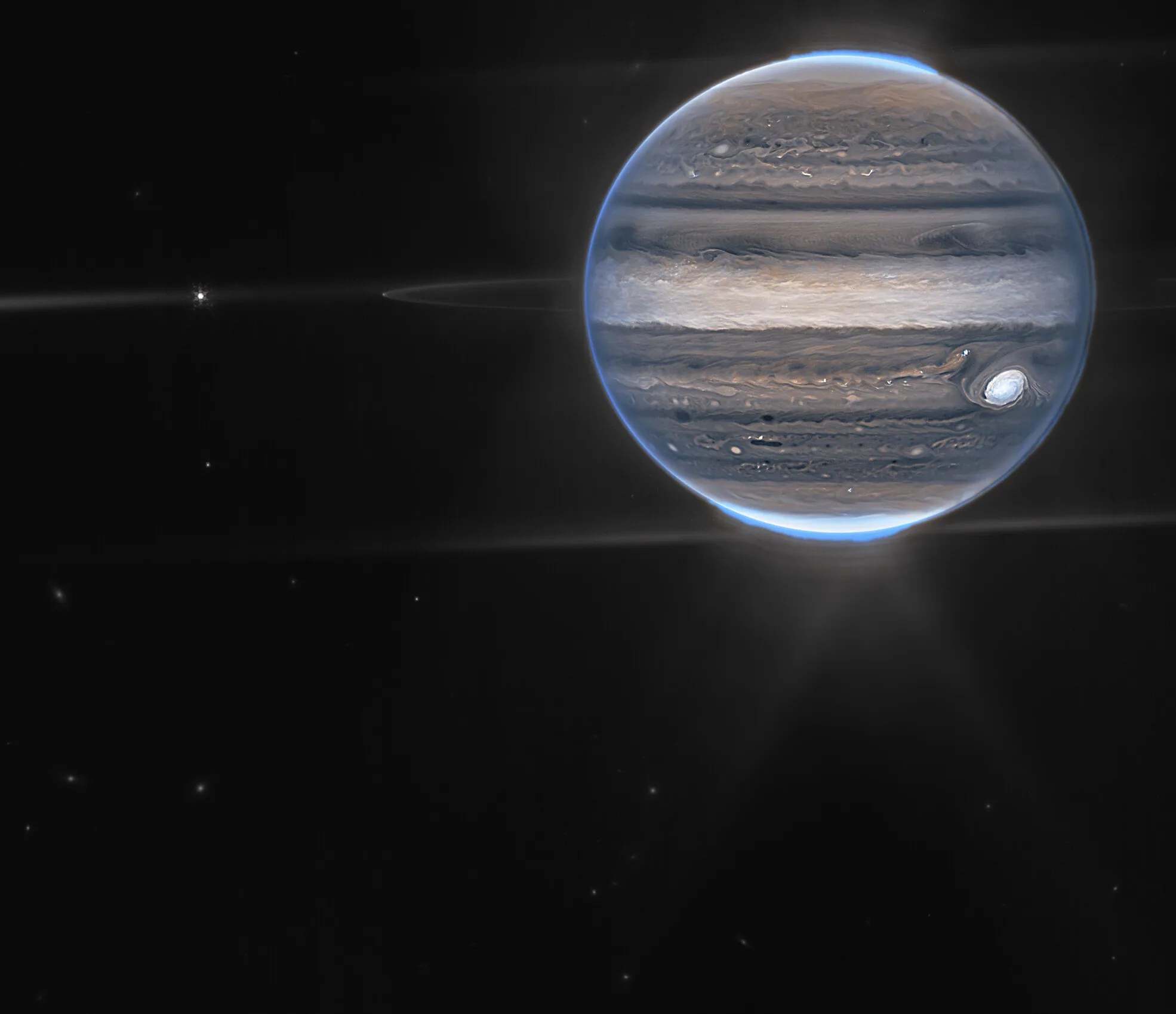
This image depicts a field of hundreds of galaxies of various shapes, colors and sizes. Most are small while a...
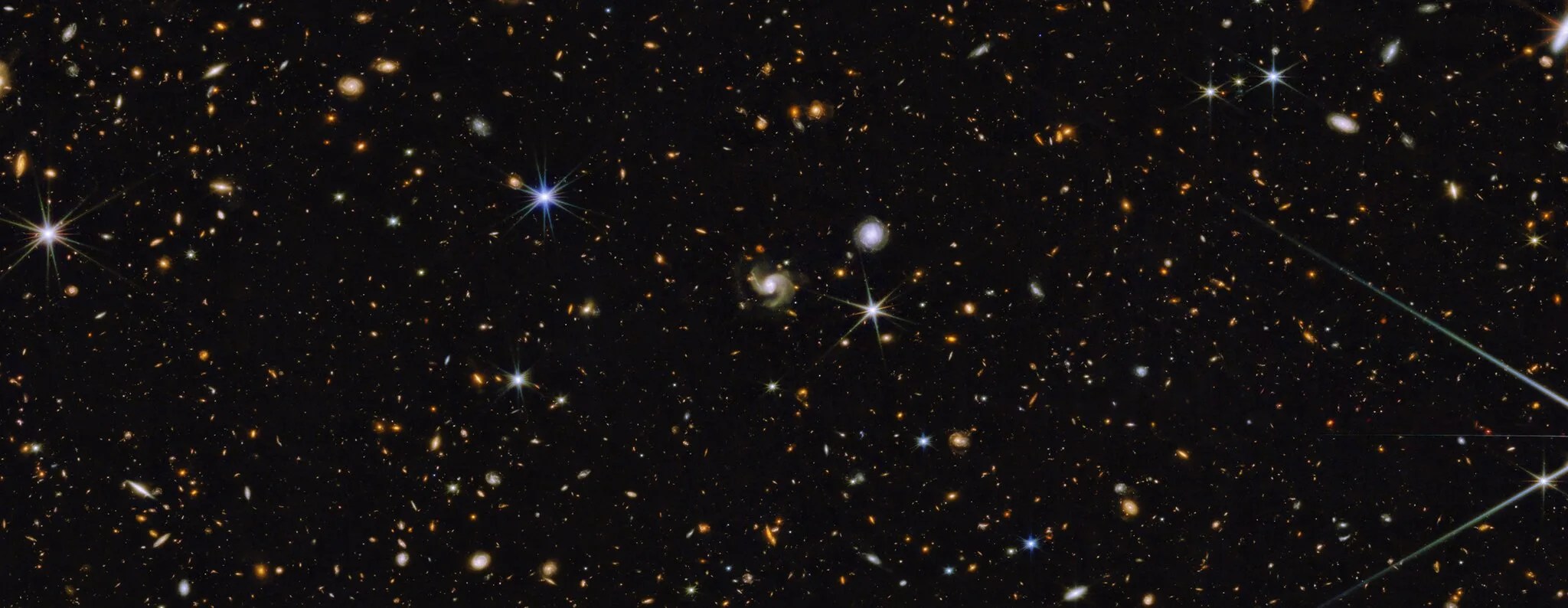
The eerie landscape is captured this time by the James Webb Space Telescope’s mid-infrared instrument (MIRI). Mid-infrared light specializes in...
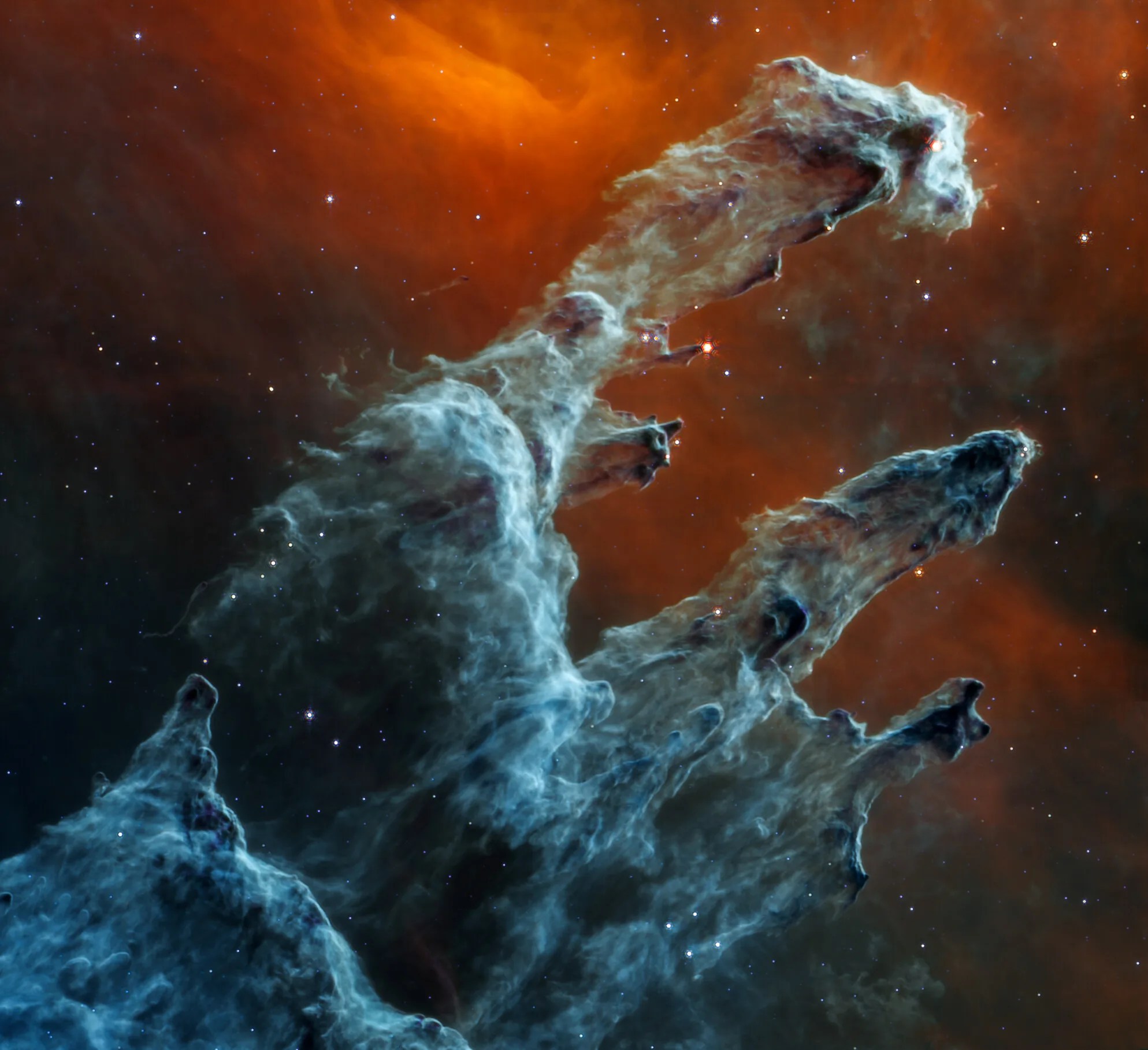
By combining images of the iconic Pillars of Creation from two cameras aboard NASA’s James Webb Space Telescope, the universe...
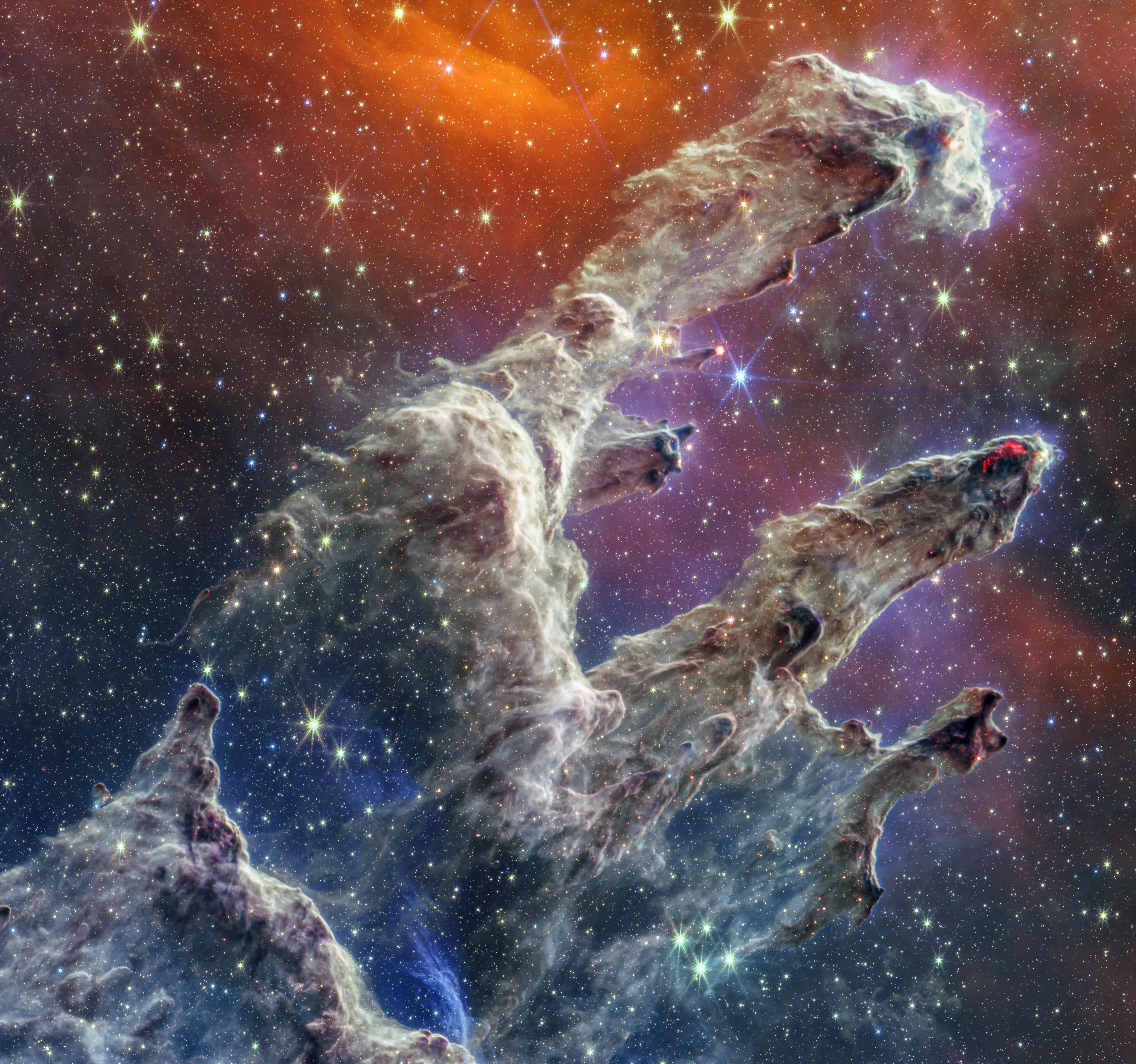
NASA’s Webb Captures Dying Star’s Final ‘Performance’ in Fine Detail
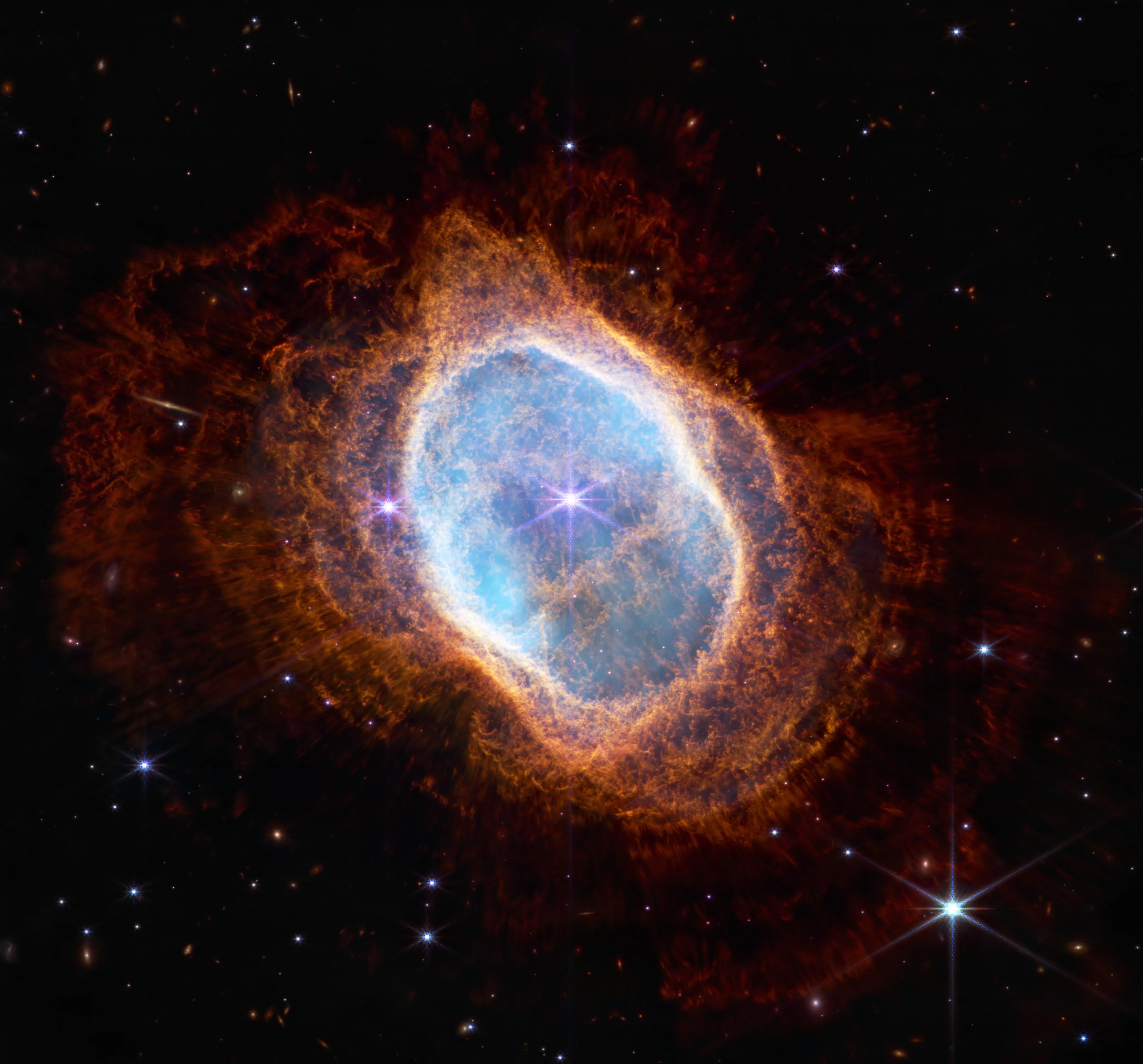
Behind the curtain of dust and gas in these “Cosmic Cliffs” are previously hidden baby stars, now uncovered by Webb....
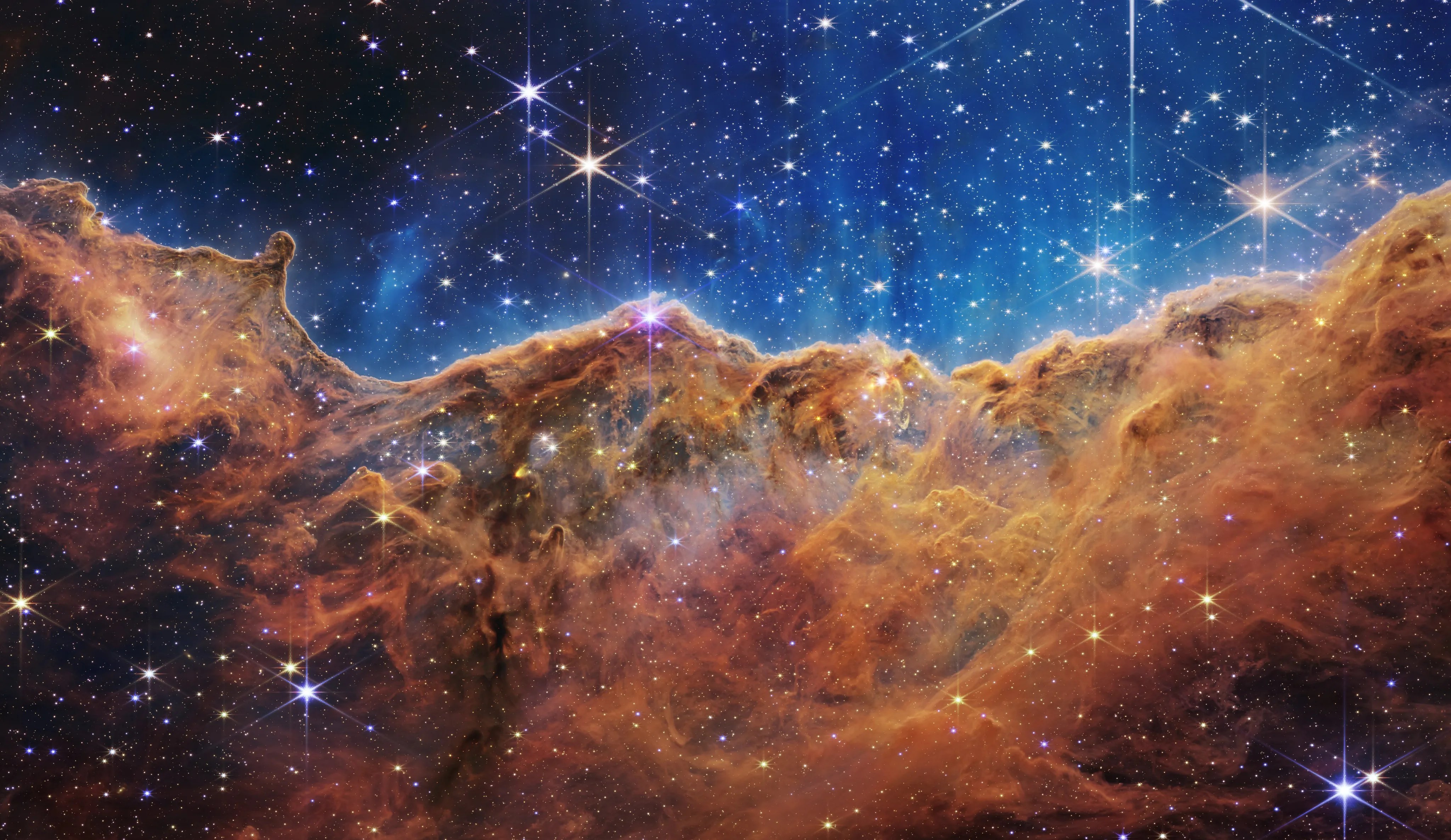
In the James Webb Space Telescope’s image of Stephan’s Quintet, we see 5 galaxies, 4 of which interact. (The left...
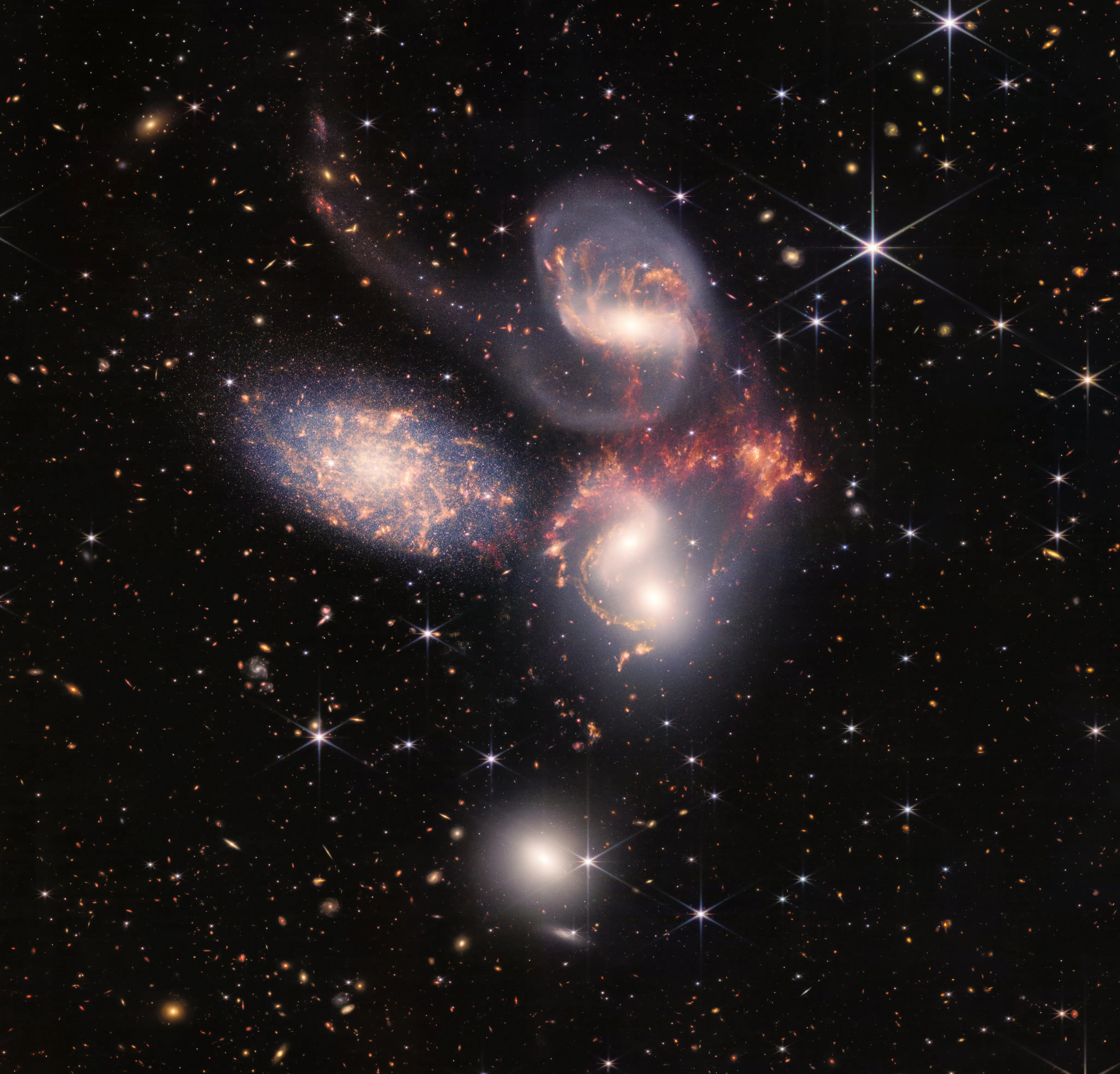
galaxy cluster SMACS 0723 is overflowing with detail. Thousands of galaxies – including the faintest objects ever observed in the...
